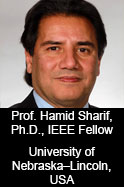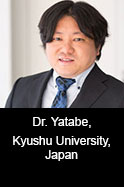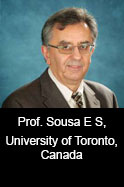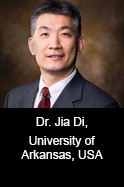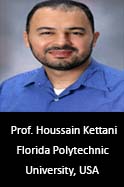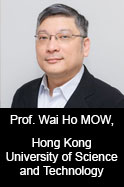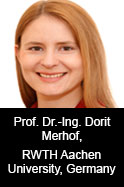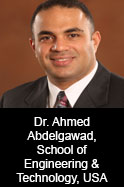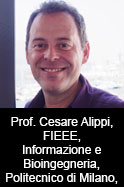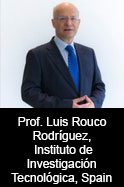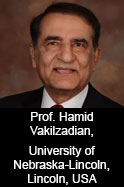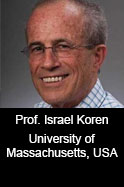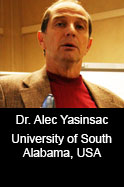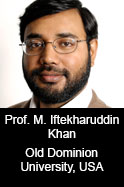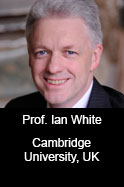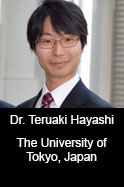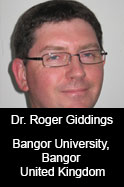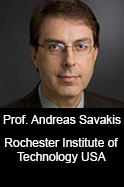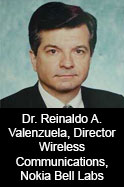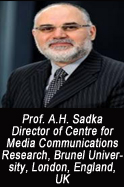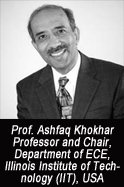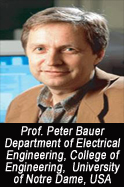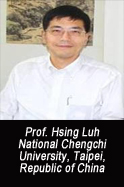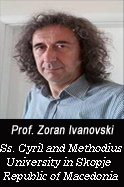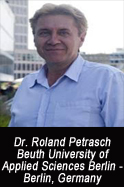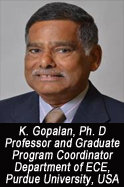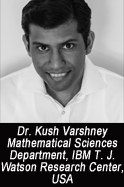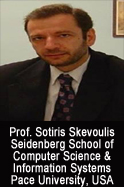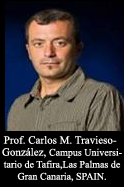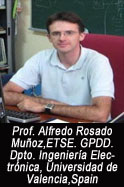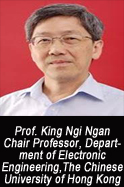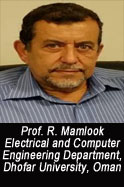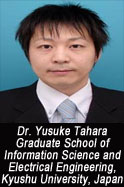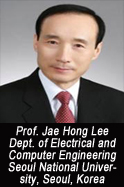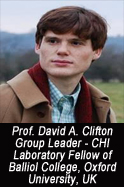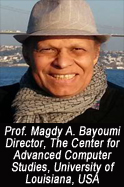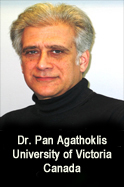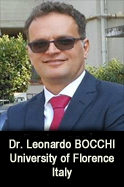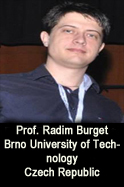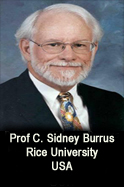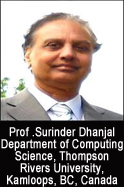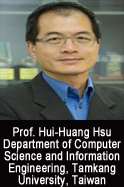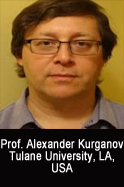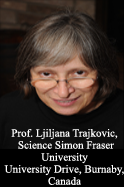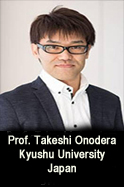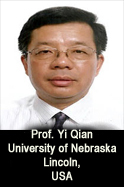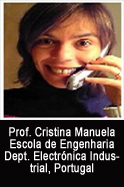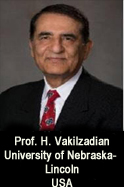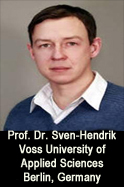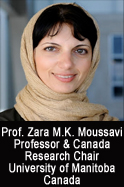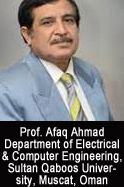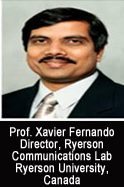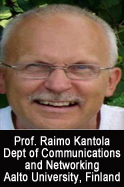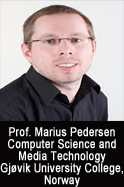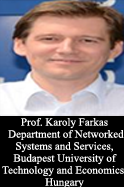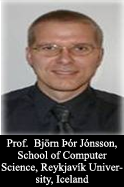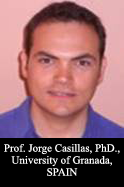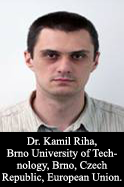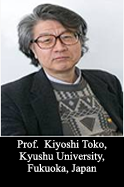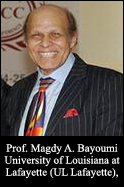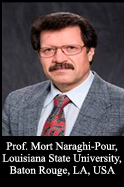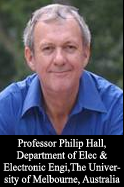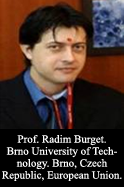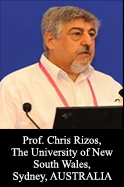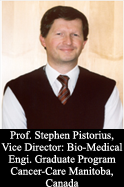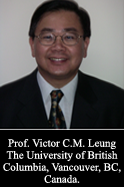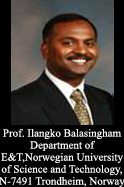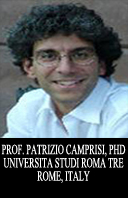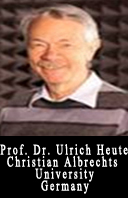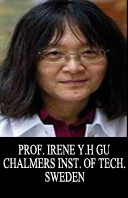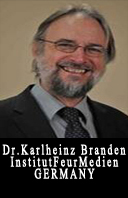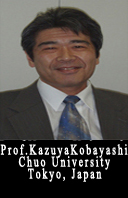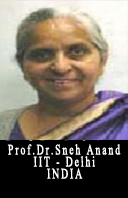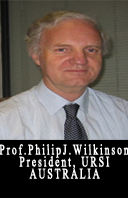Invited Talks
Invited talks of SPIN 2019

Speaker : Dr. Jeyaprakash Chelladurai, Lock Haven University of Pennsylvania, USA
Title : Modeling the development of Physcomitrella patens leaves
Abstract : Tissue and organ development in plants are intimately linked. Early leaves of the model plant Physcomitrella patens consist of a single layer of cells. Although cellular patterns are thus easily observable, live imaging of developing Physcomitrella leaves has remained technically challenging. To describe and understand Physomitrella leaf development from the initial apical cell to the mature leaf form, we constructed a computational model integrating the information gathered from microphotographs of leaves in different stages of development and from short live-imaging sequences. A particularly puzzling observation was the transformation of diagonally-oriented cells near the leaf apex into staggered files of longitudinally-elongated rectilinear cells closer to the leaf base. To explain it, we propose two hypotheses: (1) diagonally-oriented cells are rotated to their final rectilinear position by a medio-lateral gradient of growth rates, and (2) diagonal cells undergo shape changes caused by inhomogeneous expansion of different wall segments. A biomechanical model implementing the second hypothesis produced cellular patterns consistent with the observations of real leaves. In addition to characterizing Physcomitrella leaf development at the cellular level, the model points to a possibly broad morphogenetic role of the growth-tensor discontinuities in symplastic development.Soon

Speaker : Dr. Alvaro Rocha, University of Coimbra, Portugal
Title : Telemedicine: Psychosocial Therapies through Mobile Phones – A Case Study
Abstract : Telemedicine allows health care professionals to evaluate, diagnose and treat patients at a distance using telecommunications technology. The approach has been through a striking evolution in the last years and it is becoming an increasingly important part of the healthcare infrastructure. This talk will consist in a case study presentation, about the use of a tool of cognitive behavior therapeutic intervention to improve the mental, physical and social health of a group of immigrant women users of the social services of the public system of some municipalities in Galicia region, Spain.

Speaker : Dr. Cher Ming Tan, Chang Gung University, Taiwan
Title : Identification of Electromagnetic Hot spot in Integrated Circuit
Abstract : Advancement in telecommunication and integrated circuits (IC) technology in meeting the requirements for increasing amount of data to be transferred have render IC to operate at very high frequency and circuits within IC are also closely packed. Consequently, the electromagnetic emissions (EME) from IC becomes critical, not only of the increases in their intensity, but also they will affect adjacent circuits that could result in their malfunction. To reduce the intensity of EME, current methods are using filters or spread spectrum methods. However, these methods increase the complexity of the circuit board and cost, and they also increase the size of the board. A better method is to tackle the problem at roots from the IC layout itself. To identify the roots, it is important to locate the sources or hot spots in IC that are producing the unwanted EME. Near field measurement is limited in its resolution for today densely packed IC. In this talk, I will present a computational method that allow us to identify the hot spots in an IC for a given layout. Once the hot spots are identified, one can reduce the EME intensity through proper layout. In this talk, I will also present the effect of layout on the EME. As the computational method can be done using gds file, one does not need to fabricate a chip and yet able to examine if a IC design and layout are acceptable from the EME viewpoint. This can save significant cost as fabrication is only needed after EME optimization is completed.
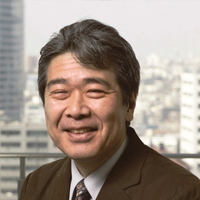
Speaker : Dr. Kazuya Kobayashi, Chuo University, Japan
Title : Wiener-Hopf Analysis of the Diffraction by a Finite Parallel-Plate Waveguide with Material Loading
Abstract : The analysis of electromagnetic scattering by open-ended metallic waveguide cavities is an important subject in the prediction and reduction of the radar cross section (RCS) of a target. This problem serves as a simple model of duct structures such as jet engine intakes of aircrafts and cracks occurring on surfaces of general complicated bodies. Some of the diffraction problems involving two- and three-dimensional cavities have been analyzed thus far based on high-frequency techniques and numerical methods. It appears, however, that the solutions due to these approaches are not uniformly valid for arbitrary dimensions of the cavity. Therefore it is desirable to overcome the drawbacks of the previous works to obtain solutions which are uniformly valid in arbitrary cavity dimensions. The Wiener-Hopf technique is known as a powerful, rigorous approach for analyzing scattering and diffraction problems involving canonical geometries. In this paper, we shall consider a finite parallel-plate waveguide with four-layer material loading as a geometry that can form cavities, and analyze the plane wave diffraction rigorously using the Wiener-Hopf technique. Both E and H polarizations are considered. Introducing the Fourier transform of the scattered field and applying boundary conditions in the transform domain, the problem is formulated in terms of the simultaneous Wiener-Hopf equations. The Wiener-Hopf equations are solved via the factorization and decomposition procedure leading to the exact solution. However, this solution is formal since infinite series with unknown coefficients and infinite branch-cut integrals with unknown integrands are involved. For the infinite series with unknown coefficients, we shall derive approximate expressions by taking into account the edge condition. For the branch-cut integrals with unknown integrands, we assume that the waveguide length is large compared with the wavelength and apply a rigorous asymptotics. This procedure yields high-frequency asymptotic expressions of the branch-cut integrals. Based on these results, an approximate solution of the Wiener-Hopf equations, efficient for numerical computation, is explicitly derived, which involves a numerical solution of appropriate matrix equations. The scattered field in the real space is evaluated by taking the inverse Fourier transform and applying the saddle point method. Representative numerical examples of the RCS are shown for various physical parameters, and the far field scattering characteristics of the waveguide are discussed in detail. The results presented here are valid over a broad frequency range and can be used as a reference solution for validating other analysis methods such as high-frequency techniques and numerical methods.
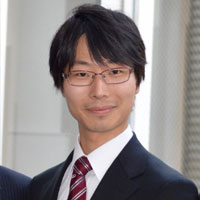
Speaker : Dr. Teruaki Hayashi, Department of Systems Innovation, School of Engineering, The University of Tokyo, Japan
Title : Knowledge Structuring and Network Analysis for Effective Data Exchange and Trading
Abstract : In recent years, cross-disciplinary collaboration using data from different fields has arisen amidst the global trends in big data and artificial intelligence. However, in order to realize cross-disciplinary data collaborations, it is first necessary to understand correctly the structural characteristics of the population of data existing in the real world and their relationships. To tackle the problem, the Data Jacket (DJ) is one of the solutions. The idea underlying the DJ is to share "a summary of data" as metadata without sharing the data itself, which enables stakeholders regarding data utilization to discuss the combinations of data. Our approach is not only analyzing the individual pieces of data, but also investigating the structural characteristics of the population of data. We can assess quantitatively the tendencies and characteristics of the data overall. In this invited talk, I introduce our latest technologies for activating effective data exchange and trading from the viewpoint of knowledge structuring and network analysis of data utilization.

Speaker : Dr. Yury Shestopalov, Department of Electronics, Mathematics & Natural Sciences, University of Gavle, Sweden
Title : Unique Permittivity Reconstruction in Inverse Waveguide Problems and Optimal Data Processing
Abstract : We propose a correct scenario for the unique permittivity reconstruction of lossless and lossy dielectric bodies in a waveguide. The approach employs analysis of operators of the forward scattering problems leading to justification of the unique solvability of the inverse waveguide problems under study. The proposed validation of the technique can be applied when measurements are performed at huge frequency arrays. The data processing technique is considered associated with a method of the unique solution to the inverse waveguide problems.

Speaker : Dr. Mehmet Emir KOKSAL, Associate Professor , Ondukuz Mayis University, Turkey
Title : Commutativity of Cascaded Systems and Signal Processing
Abstract : When two subsystems are connected one after the other, the connection is called chain or cascade connection; if the input-output characteristics remain the same whilst the order of connection is changed, we say that these subsystems are commutative. Although both orders give the same functioning, the performance of one of the connections can be superior to the other when the auxiliary system characteristics are considered. This talk covers the commutativity conditions of linear time-varying analogue systems and the outstanding benefits of commutativity in signal processing. They are also included the latest subjects appearing in the literature such as the transitivity property of commutativity, inverse commutativity conditions and transferring signals confidently in a way insensitive to environmental and internal disturbances in a robust structure by using commutativity proporty .
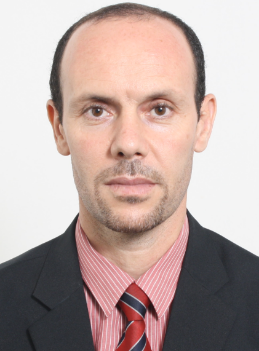
Speaker : Prof. Dr. Saad Mekhilef, Power Electronics and Renewable Energy Research Laboratory (PEARL), Department of Electrical Engineering, University of Malaya, Kuala Lumpur, Malaysia
Title : Coming Soon
Abstract : Coming Soon
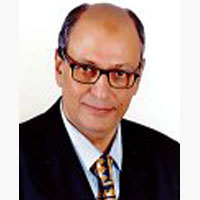
Speaker : Prof. Wahied G. Ali Abdelaal, Dean of Egyptian Academy for Engineering & Advanced Technology (EAE&AT), Affiliated to Ministry of Military Production, Egypt
Title : Industry 4.0 & Internet of Things (IIoT)
Abstract : Industry 4.0 describes the current era in technological advancement characterized by the integration of information technology, communication, and control in a so-called Cyber Physical System. Main drivers of Industry 4.0 include big data analytics, cloud computing, artificial intelligence (AI), Internet of Things (IoT), robotics, cyber-security, augmented reality, autonomous vehicles and additive manufacturing (3D & 4D printing technology). The Internet of Things (IoT) describes the technologies that connect objects to the internet. The IIoT refers specifically to the impact of this technology on industrial applications. Together, IIoT technologies create “smart” networks. For example, a smart factory provides plant managers with visibility, analytics, and remote access to wirelessly connected machines. IIoT technologies offer several important capabilities for factory automation including remote monitoring, predictive maintenance, and Overall Equipment Effectiveness (OEE) calculations. In this talk, Industry 4.0 will be overviewed. Internet of things will be presented. Then, Industrial internet of things will be highlighted. Finally, different applications for smart manufacturing using internet of things and robotics technologies will be demonstrated.

Speaker : Dr. Ahmed Abdelgawad Associate Professor of Computer Engineering, College of Science and Engineering, Central Michigan University, Mount Pleasant, Michigan, USA
Title : Internet of Things (IoT): Vision, Challenges, Applications, and Demonstration
Abstract : Internet of Things (IoT) is the network of physical objects or “things” embedded with electronics, software, sensors, and network connectively. It enables the objects to collect, share, and analyze data. The IoT has become an integral part of our daily lives through applications such as public safety, intelligent tracking in transportation, industrial wireless automation, personal health monitoring, and health care for the aged community. IoT is one of the latest technologies that will change our lifestyle in the coming years. Experts estimate that as of now, there are 23 billion connected devices, and by 2020 it would reach 30 billion devices. This lecture aims to introduce a practical low-cost IoT Platform. The foundations of IoT will be discussed throughout real applications. Challenges and constraints for future research in IoT will be discussed. In addition, research opportunities and collaboration will be offered to the attendees.
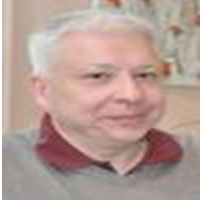
Speaker : Prof. Pavel Zahradnik, Professor, Faculty of Electrical Engineering, Dept. of Telecommunication Engineering, Czech Technical University, Prague, Czech Republik
Title : Closed-form Design of Optimal FIR Filters
Abstract : Digital filters are almost omnipresent in contemporary technology. Although filter design may seem to be a closed chapter after many decades of a research, the contrary is true. Among digital filters, finite impulse response filters (FIR) are frequently appreciated in numerous applications because of their inherent linear phase frequency response and stability. A holy grail among FIR filters represent optimal filters in terms of their length for a specified filter selectivity. These are filters with an equiripple form of their magnitude frequency response. The origin of a polynomial equiripple approximation can be attributed to P. L. Chebyshev who introduced the first equiripple approximation of a constant value in form of his famous polynomial. In the introductory part of this tutorial, we will show the history of the polynomial equiripple approximation starting its roots and first selective equiripple polynomials introduced by E. I. Zolotarev including the latest results. We will also outline why the progress in the equiripple polynomial approximation is slow despite long term efforts. In the initial technical part, we will provide the terminology and underlaying mathematical background in terms of elliptic functions. The core parts of this tutorial will introduce polynomial equiripple approximations of particular types of FIR filters, namely of narrow band-pass filters, notch filters, DC-notch filters, comb filters, half-band filters and low-pass filters including examples of the design. Particular polynomial equiripple approximations will include an approximating polynomial, differential equation of the approximating polynomial, degree equation and a simple procedure for a robust evaluation of an impulse response of a filter. Typical applications of these filter will be mentioned as well. Further, equiripple filter banks, cascade form of equiripple FIR filters and a precise tuning of equiripple FIR filters will be presented. A major emphasis will be placed on the robustness of a closed-form approach which by far outperforms any numerical design like the Parks-McClellan/Remez iterative approach. Examples will be included.
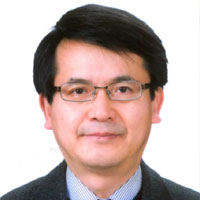
Speaker : Dr. Prof Yong Chae Jeong, Division of Electrical Engineering, Chonbuk National University, Jeonju, South Korea
Title : Negative Group Delay: A Review of Technology and Potential Applications in Communication Systems
Abstract : The group delay (GD) negatively influences the performance of RF/electronic circuits and systems, understanding effect of GD has become critical for communication systems. Negative group delay (NGD) would be promising for the GD compensation in the electronic circuits. In former part of this presentation, I will review basic concept of NGD circuit and its applications. In latter part of this presentation, I will present recent research outcomes of our group related to microwave NGD circuits

Speaker : Dr. Alexander B. Samokhin, Honored Scientist of the Russian Federation, Professor, Doctor of Science (Math. Phys.), Member of Electromagnetics Academy, USA.
Title : Coming Soon
Abstract : Coming Soon

Speaker : Dr. Boris Lagovsky, Professor, Department of Applied Mathematics, Russian Technological University, Moscow, Russia
Title : Coming Soon
Abstract : Coming Soon
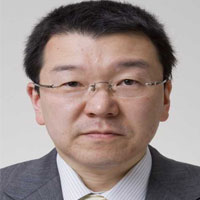
Speaker : Prof. Satoshi Yagitani, Institute of Science and Engineering, Kanazawa University, Japan
Title : Coming Soon
Abstract : Coming Soon
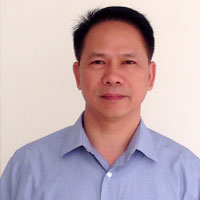
Speaker : Dr Qing Huo Liu, Professor, Duke University, USA
Title : Electromagnetic and Acoustic for Sensing and Super-Resolution Imaging
Abstract : Electromagnetic and acoustic/seismic waves have widespread applications in sensing and imaging. In these applications, often the problems of understanding the underlying wave phenomena, designing the sensing and imaging measurement systems, and performing data processing and image reconstruction require multiscale computation in acoustics and electromagnetics. It is very challenging to solve such problems with the traditional finite difference and finite element methods. In this presentation, several high-performance computational methods and super-resolution imaging in acoustics and electromagnetics will be discussed along with their applications in oil exploration and subsurface imaging.
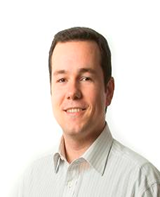
Speaker : Prof. Miguel Lopez Benitez, Dept. Electrical Eng. & Electronics, University of Liverpool, Liverpool, UK
Title : Meeting future mobile traffic demands in the era of the Internet of Things.
Abstract : Over the last several years, mobile communication networks have faced ever-increasing traffic demands beyond the available capacity, a problem that is expected to worsen in the foreseeable future with the requirement for high data-rate, enhanced Mobile Broadband (eMBB) services and the advent of a myriad of machine-type devices interconnected through the Internet of Things (IoT) for massive Machine Type Communications (mMTC). In order to cope with the forecasted traffic loads, an essential requirement for future mobile communication systems beyond 5G is efficient, flexible and dynamic spectrum utilisation. This talk will discuss some innovative approaches to spectrum sharing and on-demand spectrum assignment as a key enabling solution to provide increased capacity in mobile communication networks and support efficiently the expected traffic loads arising from IoT data.
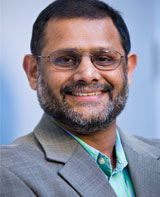
Speaker : Dr. Keshab K. Parhi, University of Minnesota, Department of Electrical & Computer Eng., Minneapolis, USA
Title : Coming Soon
Abstract : Coming Soon

Speaker : Dr. Houssain Kettani, Dakota State University, Madison, South Dakota, USA
Title : Advances in High Performance Computing
Abstract : Due to hardware limitations, parallel computing became an integral part of our lives that it is hard to imagine a device that is not using multiprocessor power, including smartphones. What started as a hardware solution to physical limitation, prompted software engineers to adopt to parallelism. This in turn, compelled theoretical computer scientists to develop theoretical solutions to algorithms design and analysis to provide a solution that is parallel oriented rather than a serial oriented one, using divide-and-conquer algorithm design technique. Due to the exponential growth in high performance computing, the fastest computer in the world is projected to run at one Exaflop/s by 2020, or 10^18 operation/second, ushering the era of exascale computing. As we move towards exascale computing and beyond, we need to keep in mind that the power of humanity is not in the powerful machines we develop, but remains in our intelligence and ability to develop solutions to problems at the basic level.
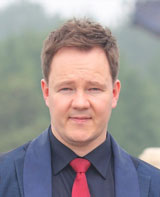
Speaker : Dr. Pavel Loskot, Senior Lecturer, College of Engineering, Swansea University, United Kingdom
Title : Internet Access in Remote Areas
Abstract : Access to Internet has been recognized as one of the key conditions to economic and social developments of countries and regions. It can mitigate or even revert migration to cities, and thus, contribute to sustainability by making rural remote places more attractive for living. Although there is much hope for emerging 5G systems with LEO satellite and high attitude platform radio access networks, these new technologies do not address - for different reasons - fundamental challenges of providing Internet in remote, sparsely populated areas. Moreover, Internet drivers and expectations in remote areas differ from those found among urban and sub-urban populations. In this talk, we will discuss technical and regulatory strategies for providing viable Internet access in remote areas despite general bias towards supporting Internet connectivity for users in high density areas.

Speaker : Dr. Victor Govindaswamy, Concordia University Chicago, USA
Title : Coming Soon
Abstract : Coming Soon

Speaker : Dr. Carlos M. Travieso-Gonzalez, Head of Signals and Communications Department, Universidad de Las Palmas de Gran Canarita”, SPAIN
Title : Developing new technological modalities for the study of neurodegenerative diseases.
Abstract : Nowadays, there are many studies and researches in order to analyze neurodegenerative diseases. Each reference develops and applies its modality with better or worse accuracy, but always on an innovative way. The multidisciplinary work between Engineers and Medical Doctors is key in order to have success in this process. The most approaches use advance and expensive medical devices as an element to have evidences and samples for analyzing. Its results can be considered as good and as useful diagnosis aids for the medical tasks. This proposal shows a new technological modality and the fusion with other modalities, which are low cost proposals and they offer good results for the analysis of neurodegenerative diseases. The idea is to build an adequate knowledge and a good validation process in order to reach new diagnosis aids for an extended use. Thus, the biomedicine advances are not limited to expensive and complicated medical devices, but it can be applied to each person.
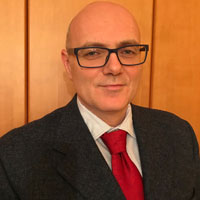
Speaker : Prof. Juan Jose Garcia Departament d'Enginyeria Electrònica Grup d'Aplicacions Electro-Magnètiques Industrials (GAEMI) Escola d'Enginyeria, Despatx QC-3025 Campus de la UAB · 08193 Bellaterra (Cerdanyola del Vallès) · Barcelona · Spain
Title : Metamaterial Impedance Network for RF-Energy Harvesting System.
Abstract : This paper evaluates the possibility to use a metamaterial transmission line as a wide band Impedance Matching Network for a RF-Energy Harvesting System operating at GHz frequencies. Some simulations analysis are showed and discussed to evaluate the performance and main characteristics of the technique
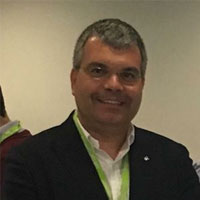
Speaker : Dr. Rafael F. S. Caldeirinha, Instituto de Telecomunicações, Leiria, Portugal
Title : 3-D Radio Coverage Tool for Mission-critical Operations in Highly Dense Forest Areas Under Wildfire Environments - the Portuguese RESCuE-TOOL Project
Abstract : Following the forest fires that devastated most of the Portuguese forest landscape last summer, coupled to the emergency communications system recovery failures, this keynote addresses the current research work on radiowave propagation phenomena in rural areas, particularly under wildfire environments. This builds up on more than 20 years of research work on attenuation in vegetation media. In the first part of the keynote, an overview on current research approaches and propagation models for attenuation in vegetation, developed within the research group on ”Antennas and Propagation –Lr” of the Instituto de Telecomunicações, in Portugal, and University of South Wales, in the UK, along with some results and comparisons with experimental data gathered at various scenarios and signal frequencies, will be provided. This is a result of the work that has been done in Europe, particularly at the standardisation bodies, in which contributions have been made to predictions models and measured data to the International Telecommunication Union – Radiocommunication Sector (ITUR) recommendations on Propagation (P), i.e. ITU-R P.833-5. Topics will address formulation of possible extensions of the ITUR P.833-9 based on recent results on analytical and experimental studies directed at the characterisation and modelling of vegetation media effects on propagation and radio system design, including dynamic effects. The second part of the keynote will address the most recent developments on the development of a simulation framework to enhance the quality, performance and the resilience of the emergency radio communication systems during a wildfire event. To this extent, on-going research work includes several studies that will contribute for the better understanding of the propagation effects on radio signals under fire environments, the development of a fire-front building up model, the development of a radio propagation tool to obtain coverage maps based on relevant models for propagation in rural areas, particularly in highly dense forest areas, taking into account the topography and clutter in the radio path and the integration of wildfire build up models into the radio propagation tool for an all encompassing radio coverage tool to aid ground forces in realtime with identification of radio exclusion zones in real-time as fire-front develops.
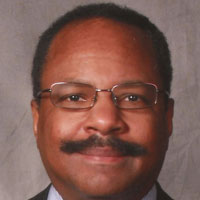
Speaker : Dr. Héctor J. De Los Santos, NanoMEMS Research, LLC, Irvine, California, USA
Title : Coming Soon
Abstract : Coming Soon

Speaker : Dr. Sheel Aditya, School of Electrical & Electronic Engineering, College of Engineering, Nanyang Technological University, Singapore
Title : Emerging Technologies for Communications and Healthcare
Abstract : This talk will focus on a few selected emerging as well as proposed technologies that are related to communications and healthcare. In particular, the role of RF and microwaves in these technologies will be emphasized. As the current generation of mobile networks struggles to keep up with the demand, 5G cellular networks have been proposed. The latest generation of networks will exploit the so far under-utilized millimetre-wave bands and promises to improve data rates, capacity, as well as quality-of-service. Next, the talk will describe utilization of RF/microwave technologies in healthcare. A significant growth of research has been taking place in this arena. The third technology touched upon in this talk relates to access to the internet. While such access is now considered necessary, a large majority of world’s population is still unable to have high-speed connectivity to the internet. An Internet-of-Space based on satellites and other airborne platforms has been proposed to plug this gap. The talk will end with a brief description of the latest developments in the area of travelling-wave tubes (TWTs) which are used in satellites and other airborne platforms. These developments include the application of microfabrication techniques to achieve ever-higher frequencies of operation.
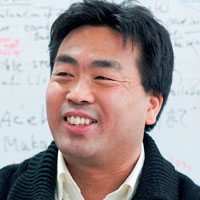
Speaker : Dr. Yasuhide Hobara, Professor, Department of Computer and Network Engineering, Graduate School of Informatics and Engineering, The University of Electro-Communications (UEC), Tokyo, Japan
Title : Lightning application to extreme weather
Abstract : Lightning discharge is one of the most common and intensive natural electrical phenomena in the terrestrial atmosphere. Lightning generate strong electromagnetic pulses known as sferics in the wide frequency ranges and propagate over a long distance. In this talk, I am going to demonstrate one of the practical applications of lightning to monitor and short-term forecast extreme weather phenomena such as Tornadoes, wind gust, and heavy rain fall causing flash flood etc. These extreme meteorological events increase worldwide due to the global climate change. The total lightning (TL) data from JTLN (Japanese Total Lightning Network) in the time period from 2014 to 2018 were analyzed. JTLN has been deployed by UEC, detects the DC to HF electric field of sferics and identifies the position, polarity and peak current (Ip) of both IC (in cloud lightning) and CG (cloud to ground stroke) from thunderstorm activities around Japan. Results obtained indicate promising for early warning because the stroke rate of TL tends to increase about 10 ~ 40 minutes before the onset of the extreme weather events typically associated with sudden increase of the stroke rate so-called lightning jump (LJ). Moreover, positive linear relation with rather high cross correlation (r ~ 0.7 between TL and Precipitation Volume (PV) [m3] has been obtained. TL can be promising tool to estimate heavy rainfall in space and time only from lightning distribution.

Speaker : Dr. Kumar Vijay Mishra, University of Iowa - IIHR, 100 Stanley Hydraulics Lab, Iowa City, IA
Title : Compression, cognition and coexistence in radars
Abstract : In the past few years, novel approaches to radar signal processing have been introduced which allow the radar signal detection and parameter estimation using much smaller number of measurements than required by Nyquist sampling. These systems exploit the fact that the target scene is sparse facilitating the use of recent advances in compressed sensing methods. This talk will introduce recent developments in reduced-rate sampling that break the link between common radar design trade-offs such as range resolution and transmit bandwidth; dwell time and Doppler resolution; spatial resolution and number of antenna elements; continuous-wave radar sweep time and range resolution. For each of these ideas, we present state-of-the-art hardware prototypes that we have designed and developed to demonstrate the real-time feasibility. We examine extensions to diverse applications such as cognition, spectral coexistence, matrix completion, autonomous driving, ground penetration radar, multiple-input-multiple-output and synthetic aperture radars. Finally, we connect the cognition in radars to some interesting applications of deep learning.
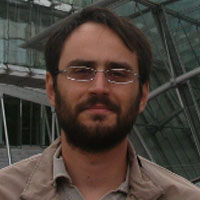
Speaker : Dr George A. Ropokis, Assistant Professor, Signal Communication and Embedded Electronics research team, CentraleSupélec, Campus Rennes, Rennes, France
Title : Optimization techniques for wireless powered relaying systems
Abstract : Cooperative communications techniques can offer a true solution towards increasing reliability of wireless networks and network coverage. However, to enable such system designs, energy sustainable network nodes are required that could act as relays for our design. To this end, in this talk we will investigate the use of wireless power transfer techniques as a means of providing energy resources to wireless network relays. In more detail, we will discuss the design of optimization techniques allowing for the optimal allocation of energy resources available to both the source of our cooperative system as well as to the wireless powered relay. Focusing on mutli-antenna equipped relays, we will study the optimal beamforming problem at the wireless powered relay, in combination with the problem of optimal power allocation at the source of our cooperative system. Extensions to systems exploiting multiple relays will also be discussed.
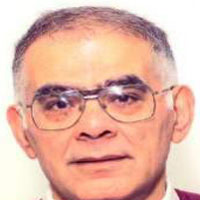
Speaker : Dr. Yahia Antar, Professor of Electrical and Computer Engineering, Royal Military College of Canada, Canada
Title : Coming Soon
Abstract : Coming Soon
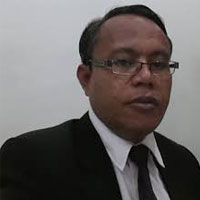
Speaker : Dr Elyas Palantei, Universitas Hasanuddin, Makassar, Indonesia
Title : Printed UWB Microwave Transducer for Biomedical Sensing and Imaging
Abstract : High precision of printed UWB microwave transducer used for sensing and monitoring various human tissues in biomedical applications such as breast cancer and fetal growth was optimally computed. The single printed element of UWB transducer that successfully modeled through several numerical optimizations was multiply fabricated and configured with a PC based sensing and imaging unit. One sample of UWB microwave transducer designed through the numerical computation and optimization was selected to be fabricated. The spherical transducers array consisted of twelve stair printed board elements was also configured. Each element was individually measured to characterize its electrical properties, especially the return loss parameter. The comparison of S11 profiles of all UWB sensor elements is discussed. The constructed UWB transducer is well verified using HFSS programming, CST programming and experimental measurement as well. Numerically, both HFSS and CST confirmed the potential operation bandwidth of UWB transducer is more or less 4.5 GHz. However, the measured bandwidth provided is about 1.2 GHz due to the technical difficulties existed during the manufacturing step. The UWB microwave sensing and monitoring system implemented consists of 12 elements UWB printed transducers, a vector network analyzer (VNA) to perform as the transceiver and signal processing part, the PC Desktop/Laptop acting as the image processing and displaying unit. In practice, all the reflected power collected from whole tissue surfaces of particular artificial human organ such as breast and abdomen are grouped into several numbers of pixel color classes positioned on the corresponding row and column (pixel number). The total number of power pixels applied in 2D-imaging process was specified to 100 pixels (or the power distribution pixels dimension 10x10). This was determined by considering the total whole size of both Asian women breast and abdomen, respectively, and synchronized with the single UWB transducer physical dimension. The interesting microwave imaging results were plotted and together with some technical problems arisen on developing this sensing and monitoring system are discussed in the plenary talk.

Speaker : Dr. Shinichiro Ohnuki (Ph.D.), Department of Electrical Engineering, College of Science and Technology, Nihon University, Kanda, Surugadai, Chiyoda-ku, Tokyo, Japan
Title : Time-Domain Parallel Algorithms for Electromagnetic Wave Analysis
Abstract : We will introduce recent our progress of highly efficient parallel algorithms toward solving electromagnetic problems [1][2]. Our algorithm has been designed to completely parallelize finitedifference schemes using recently developed numerical techniques to obtain electromagnetic wave responses at arbitrary time. The computational speed can be accelerated in proportion to the number of distributed computers with the same parallel efficiency. In this talk, we will verify the reliability of these computational techniques and demonstrate the ability.

Speaker : Dr. Prabhakar H. Pathak, Professor Emeritus, Department of Electrical and Computer Engineering, The Ohio State University College of Engineering, Columbus, US
Title : APPLICATION OF BEAM TECHNIQUES TO SOME EM PROBLEMS
Abstract : A review of beam methods is presented with applications to some EM problems. Complex Source Beams ( CSBs ) and Gaussian Beams ( GBs ) exhibit a focused wave behavior about their propagation axis, which is characterized by an exponential decay away from their axis. As such, they can serve as a useful set of overlapping basis functions for representing relatively arbitrary EM fields. CSBs are exact solutions of Maxwell's equations, while GBs are asymptotic solutions of the wave equation. In the paraxial limit, CSBs can be seen to reduce to GBs. GBs are seen to be more general, while CSBs have other useful properties. Methods for expanding EM fields into a set of CSBs, or GBs, will be discussed along with their advantages. Use of CSBs and GBs for the rapid analysis/design of large reflector antennas, and for obtaining efficient moment method based solutions to governing EM equations of radiation/scattering problems, as well as for relatively simple antenna near field to far field transformations in antenna measurements, respectively, will be discussed. Numerical results will be presented to demonstrate the utility and accuracy of the CSB/GB techniques for the above class of problems.

Speaker : Prof. Brian Barsky, Computer Science Division School of Optometry, Berkeley Center for New Media, Berkeley Institute of Design Arts Research Center, Berkeley University of California, Berkeley, USA
Title : Simulating Human Vision and Vision Correcting Displays.
Abstract : Present research on simulating human vision and on vision correcting displays that compensate for the optical aberrations in the viewer's eyes will be discussed. The simulation is not an abstract model but incorporates real measurements of a particular individual’s entire optical system. In its simplest form, these measurements can be the individual's eyeglasses prescription; beyond that, more detailed measurements can be obtained using an instrument that captures the individual's wavefront aberrations. Using these measurements, synthetics images are generated. This process modifies input images to simulate the appearance of the scene for the individual. Examples will be shown of simulations using data measured from individuals with high myopia (near-sightedness), astigmatism, and keratoconus, as well as simulations based on measurements obtained before and after corneal refractive (LASIK) surgery.
Recent work on vision-correcting displays will also be discussed. Given the measurements of the optical aberrations of a user’s eye, a vision correcting display will present a transformed image that when viewed by this individual will appear in sharp focus. This could impact computer monitors, laptops, tablets, and mobile phones. Vision correction could be provided in some cases where spectacles are ineffective. One of the potential applications of possible interest is a heads-up display that would enable a driver or pilot to read the instruments and gauges with his or her lens still focused for the far distance. This research was selected by Scientific American as one of its ten annual "World Changing Ideas.”
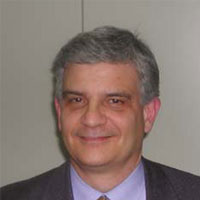
Speaker : Prof. Giuliano Manara, Professor, College of Engineering, University of Pisa, Italy
Title : Resorting to a Near-Field Focused Microwave Antenna is Sometimes More than Just an Option
Abstract : Focusing the electromagnetic field radiated by an antenna at a point in the antenna near-field region is a well-known technique to increase the electromagnetic power density in a size-limited spot region close to the antenna aperture. This speech encompasses the basic working principles of the near-field focused antennas and the main design criteria proposed for near-field shaping around the focal point. A brief overview of the applications of such specific class of antennas is also provided.
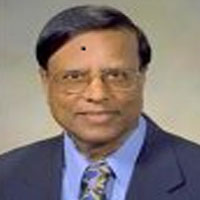
Speaker : Prof. Raj Mittra, University of Central Florida, USA
Title : Coming Soon
Abstract : Coming Soon
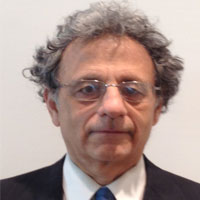
Speaker : Dr. Demetrios N. Matsakis, US Naval Observatory, 3450 Massachusetts Ave NW, Washington DC, United States
Title : The Behavior of Controlled Clocks
Abstract : An important issue in using proportional steering to control clocks is to set the gain, which is a vector that is multiplied (via dot-product) with your best estimate of your clock’s state vector (phase and frequency with regards to the reference) to determine the magnitude of your steer. This applies in steering a remote clock to a master clock, and to some extent in steering a timing lab’s clocks to Coordinated Universal Time (UTC). If there is no delay between measurement and the implementation, one can chose the gain to minimize a combination of frequency RMS, phase RMS, and control effort, which is defined as the RMS of the steering corrections and which determines the degree to which the controlled clock is disciplined. Alternately, one could set the gain functions so as to set the time constant – in doing this one might prefer to choose critical gains, which would avoid oscillatory behavior and be characterized by a single time constant. These two approaches have been used by the U.S. Naval Observatory and others for many decades, and they are succinctly described in Koppang, Metrologia 42, 2016. In our presentation we unify these approaches, providing a pictorial representation that describes both these classes of quantities in terms of any set of gains. Although there will be no equations solved in the presentation, the text will outline the approach required for the underlying analysis; these can be generalized to more complex state and steering functions, such as those characterized by phase, frequency, and drift. In the text, equations will be derived in the text (though not in the presentation) which rely heavily on the concept of stationarity in order to compute the phase, frequency, and control variances to be expected. In the text, the eigenvalue approach and the unit circle in the Z-transform formalisms for deriving the time constants for responses to a disturbance will also be explained. We also show how other quantities, such as the Allan Deviations and the frequencies in the oscillatory regime can be computed. These have been confirmed by simulations. The formulas and plots reflect the Separation Theorem, which states that the optimal steering strategy can be separately determined from the optimal state estimation. These plots to be presented would enable one to select the most desirable gains without necessarily needing to repeat the calculations, and to understand the consequences if the gains are set different from those finally decided. In the text, we will also extend the math to compute the degradation in performance when the state is suboptimally (i.e. incorrectly) estimated, or when there is a lag between the measurements and the steer implementations, as happens routinely in steering to realize UTC, because the Circular T arrives about ten days after the end of the moth. In both cases, the magnitude of the quantitative loss depends strongly on the measurement noise and underlying clock stabilities. Plots quantifying these losses will be presented. Examples from simulations will be provided in the text, and a very few in the presentation itself.
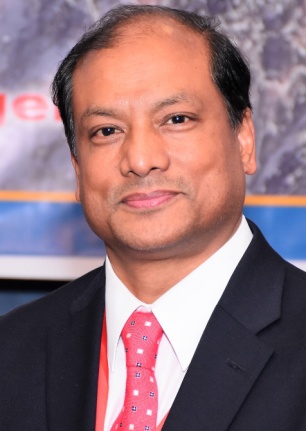
Speaker : Dr. Dinesh Manandhar, Associate Professor (Project), Center for Spatial Information Science, The University of Tokyo, Japan
Title : Coming Soon
Abstract : Coming Soon

Speaker : Dr. Sastri Kota, Centre for Wireless Communication,University of Oulu, Finland
Title : Coming Soon
Abstract : Coming Soon

Speaker : Prof. Magdy A. Bayoumi, Director, Center of Advanced Computer Studies,University of Louisiana at Lafayette, USA
Title : Brain on Chip
Abstract : The brain has been always a mystery for humanity to figure out, the main question has been: can we read the brain? It may be a far fetched goal, but the road to solve has been fascinating. Brain Computer/Machine Interface (BCI/BMI) is one of the enabling technologies to reach this ultimate goal. BCI/BMI has a great potential for solving many physically challenged people's problems (e.g., restoring missing limb functionality) via neural-controlled implants. We have designed and developed a BCI chip that overcome the main challenges of low bandwidth communication, small chip area, low power, low heat dissipation, and tolerant to noise. The chip is adaptive and has simple architecture and circuits. The power consumption is reduced, but, and the accuracy of the system has improved up to 93.5% in the worst case. Depending on the application needs (Limb control application on mental disorder monitoring and detection), the proposed architecture could be use in an invasive closed-wound implant as well as a minimal invasive Implants. The proposed architecture was simulated in Matlab and implemented in Verilog, Modalism and Cadence. A case study of early prediction/warning and detection of epilepsy seisure will be illustrated.

Speaker : Dr. Phil Menard, Assistant Professor of Information Systems, University of South Alabama, Alabama (USA)
Title : Analyzing IoT Users' Mobile Device Privacy Permissions: A Disclosure Experiment
Abstract : The Internet of Things (IoT) has entered public awareness due mostly to using IoT devices for creating smart homes. Although IoT provides numerous benefits due to increased information and control, the technology also introduces various vulnerabilities. IoT vendors have rushed products to market with little concern for security or privacy implications. Humans are the weakest link, but there are few opportunities to introduce preventative interventions for mitigating potential security breaches in home contexts. Part of the solution is identifying users' concerns related to the privacy of their IoT-managed information and examining how those concerns are weighed in IoT adoption decisions. In this research, we examine the privacy concerns of IoT users in light of the increased data disclosure that is often central to the utility of IoT devices. We used an experimental design capturing users' privacy perceptions as well as the actual privacy allowances on their mobile devices.
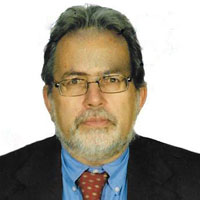
Speaker : Professor Christodoulos Chamzas, Democritus University of Thrace, School of Engineering, Department of Electrical and Computer Engineering, Division of Electronics and Information Systems Technology, Laboratory of Electric Circuits Analysis, University Campus, Kimeria, Xanthi, 67100 Greece
Title : Incorporating Geometry Images in the retrieval process of 3D models
Abstract : The aim of this work is to extend the way 3D content-based retrieval is usually being performed and hence proposes the utilization of Geometry Images. We will describe two cases.
Texture, the neglected companion of 3D objects. We propose the generation of a spatially-consistent UV map by exploiting computational geometry and planar mesh parameterization. Having the texture of a 3D object depicted on a completely 2-dimensional structure and without inconsistencies, enables us to exploit well-known algorithms derived from the image processing domain and apply them on the object’s texture map.
Curveture-Geometry Images: We propose a method to represent a 3D model’s surface on a 2D regular grid and encode its k1curvature, thus producing a new 3D geometry feature, the CurvMaps, that may be used for 3D model classification. The feature creating transformation relies on the identification of a 3D model’s geometrical “extrema”, the computation of k1 principal curvature and its encoding into a 2D regular grid. The applicability of CurvMaps and a convolutional neural network architecture both in 3D model classification and retrieval is being discussed through the experimentation with a number of classical methods.
Invited talks of SPIN 2018
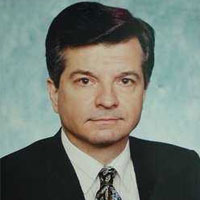
Speaker: Dr. Reinaldo A. Valenzuela, Director Wireless Communications, Nokia Bell Labs, USA
Title: 5G Physical Layer: Technology Opportunities and Challenges
Abstract: The insatiable demand for media rich content and the increasing availability of advanced devices such as smart phones, tablets, etc., has forced the mobile communications eco system to start in earnest to consider the next generation solutions to address these needs. Some of the options being mentioned as ingredients for such 5th Generation mobile radio systems include Small Cells, HetNets, Carrier Aggregation, Machine-to-Machine, Internet-of-Things, Relays, Device-to-Device and operation in the millimeter wave spectrum range, among others. A review some of the background trends driving the evolution of broadband wireless access that will impact the technology choices beyond 2020 is considered in this talk. Also some detail of the most intriguing options service providers is included.
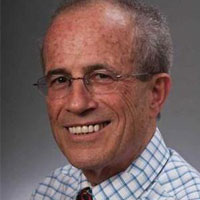
Speaker: Prof. Israel Koren Dept. of Electrical and Computer Engineering University of Massachusetts, USA
Title: Soft and Permanent Errors in CMOS Active Pixel Sensors: Analysis, Detection, and Tolerance
Abstract: The CMOS Active Pixel Sensor (APS), like any other digital circuit, is subject to both soft and permanent faults. However, the manifestation of such faults and the available techniques for detecting them and for tolerating them are very different. This tutorial summarizes the experimental and theoretical research results that we have obtained in our ongoing research of digital sensors’ defects for the last 15 years. We start by identifying the unique type of permanent faults that occur in digital cameras’ sensors. We then analyze their behavior and identify their possible source. We describe an algorithm capable of detecting these faults during the normal operation of the sensor. Such an online detection allows us to develop efficient techniques for greatly reducing their impact on the quality of the image. We next focus on soft errors (a.k.a Single Event Upsets - SEUs) that are typically caused by high-energy cosmic particle hits. We present an experimental study of SEUs in digital sensors and compare their rate to that of SEUs in SRAM memory and to the rate of permanent defects in cameras. This analysis provides important information about the nature and distribution of particle hits and their occurrence rate, and increases our understanding of SEUs in regular ICs as well as in camera sensors.
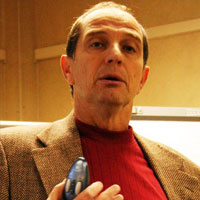
Speaker: Dr. Alec Yasinsac Professor and Dean School of Computing University of South Alabama, USA
Title: Online Voting, Issues and Opportunities
Abstract: Virtually all “information” businesses have fundamentally transformed their way of doing business in the Internet age, and many new “information” business have been enabled by online services. One information service that has not achieved its seemingly limitless potential for modernization through “app” development is “Online Voting”. We give a short history of online voting and then turn to opportunities for making advances in this important governmental information service, including providing observations on the potential for blockchain technology to contribute to online voting systems.

Speaker: Prof. Luis Rouco Rodríguez, Professor, Modelling, Analysis and Control Research Group, Smart and Green Networks Research Group, Institute for Research in Technology — Instituto de Investigación Tecnológica, Spain
Title: Power system electromechanical oscillations: modeling, estimation and control
Abstract: Poorly damped or even undamped electromechanical oscillations may ccur in power systems putting at risk the security of electricity supply. The study of power system electromechanical oscillations is aimed at the design of control schemes to improve their damping. A very successful approach to the study of power system electromechanical oscillations is based on modal analysis. Modal content can be determined by the eigenvalue analysis of the power system linear model and can also be estimated from power system signals. The lecture will review the a number of mathematical techniques of modal analysis and estimation. It will also explain how the outcome of modal analysis and estimation can be used for the design of control schemes.

Speaker: Prof. Hui-Huang Hsu, PhD, Dept. of Computer Science and Information Engineering, Dean, College of Engineering, Tamkang University, Taiwan
Title: AmI in Elderly Home Care
Abstract: We will first talk about recent advances in artificial intelligence (AI). We will also give the concepts and related technologies of ambient intelligence (AmI). We will then discuss the issues of utilizing robots and AI in elderly care. Ideas of two research projects in elderly home care will be presented. The first project is about developing a virtual human companion. The second one is related to the detection of abnormal behavior of the elderly at home with RFID.
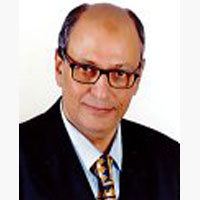
Speaker: Prof. Wahied G. Ali Abdelaal, Dean of Egyptian Academy for Engineering & Advanced Technology (EAE&AT), Affiliated to Ministry of Military Production, Egypt
Title: Industry 4.0: Opportunities and Challenges in EGYPT
Abstract: Industrial revolutions have different stages during their development. The first one has used steam power in mechanical production systems (1784). The second one has used electrical power for assembly lines and mass production (1870). The third one has used electronics and information technology to boost the automation and autonomous systems (1969). Recently, the German industry has launched the fourth one using cyber-physical production systems; that means the real and virtual worlds can be merged (2011). The fourth industrial revolution integrates the following fields: big data, augmented reality, cloud computing, additive manufacturing, autonomous robots, Internet of things (IoT), system integration, and simulation techniques. This talk will represent the opportunities (geographical location, materials and energy, infrastructure, different industries …etc) and challenges (education development, industry needs, workforce training, collaboration between industry and universities, road map for technology …etc) in Egypt to enter the age of industry 4. After the public revolution in Egypt (2011), the government hopes to improve the education quality and to increase the economic revenue in applying the strategic plan 2030. The higher education in engineering, technology, and business has to integrate new knowledge and skills to empower the local industry and to improve the industrial productivity.
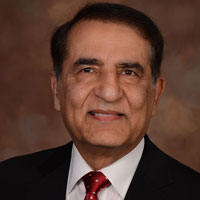
Speaker: Prof. Hamid Vakilzadian, Department of ECE, University of Nebraska-Lincoln, Lincoln, USA
Title: Quality of Service Analysis in Sequential Server Networks
Abstract: The efficient flow of data in communication networks is vital in today’s environment. These networks facilitate transmission of data from a source to a destination in the shortest time possible using a single or multiple servers/routers and links with various speeds in the path. The buffer for incoming data in the servers has to match the speed of the incoming data with the speed of the server in the datalink. Similarly, the buffer for outgoing data has to match the speed of the outgoing link with the speed of the server for smooth transfer of incoming data to the destination after service. Depending on the speed mismatch among the links and servers, a server may become idle, underused, or overloaded to a level that the limited size of the buffers may not be able to prevent congestion or loss of data in either or both incoming and outgoing directions. This degradation in the quality of service will result in longer delays, loss of data, and blocking of new incoming data.
This talk provides the research results of a sequential three-server router network with limited and unlimited server buffer sizes, varying data packet length, addition or removal of a service link to determine packet drop rate, average end-to-end delay, throughput and server utilization under exponential and uniform distributions for incoming data arrival, and Poisson distribution for a server using the OMNET++ simulator.
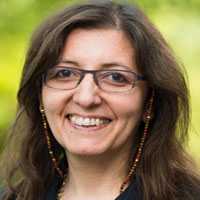
Speaker:Prof. Marjan Sirjani, School of Innovation, Design and Engineering, Malardalen University, Sweden
Title: Dependable Cyber-Physical Systems
Abstract: In this new era of Cyber-Physical systems and Internet of Things, software system developers have to deal with increasing complexity of huge and heterogenous systems. Building distributed, asynchronous, and event-based systems is a complicated task. We need models, techniques, and tools to address the complexity of the software, as well as timeliness. Moreover, software needs to react to the uncertainty and possible changes in the system and environment. A family of actor-based languages are introduced to enable model driven development and provide a natural and usable model for building distributed, asynchronous, and event-based systems with least effort. Network and computational delays, periodic events, and required deadlines can be expressed in the model. To provide dependability in the context of a model-driven approach, model checking and simulation tools are built based on the formal semantics of the language. For deadlock-freedom and schedulability analysis special techniques in state space exploration is proposed by exploiting the isolation of method execution in the model. I will show how these models can be used in safety assurance and performance evaluation of different systems, like Network on Chip architectures, sensor network applications, train scheduling, and quadricopters.
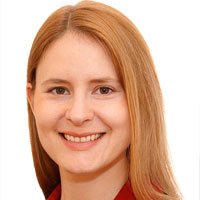
Speaker: Prof. Dr.-Ing. Dorit Merhof, Institute of Imaging & Computer Vision – Lehrstuhl für Bildverarbeitung, RWTH Aachen University, Kopernikusstraße 16, 52074 Aachen, Germany
Title: Biomedical Image Analysis and Visualization: Current Trends and Future Perspectives
Abstract: Innovative imaging and screening technologies have become fundamental to scientific progress across all disciplines of natural and life sciences. However, the actual bottleneck often lies in the handling and analysis of the vast amounts of complex data generated through these technologies, which requires expert knowledge for analysis and visualization. Interdisciplinary research between medical/biological experts and image processing specialists aims at developing dedicated algorithms for automated analysis and for interactive exploration of complex, large and/or high-dimensional scientific data repositories. Since analysis and visualization have become a real bottleneck in biomedical sciences, such data provides interesting and challenging research questions from a computer science point of view. In this talk, a review of interdisciplinary projects addressing the analysis of challenging biomedical image data such as whole-slide images in digital pathology and real-time biological video data is provided. Finally, future challenges for biomedical image analysis are discussed.
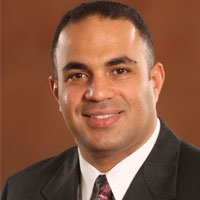
Speaker: Dr. Ahmed Abdelgawad, School of Engineering & Technology, Central Michigan University, USA
Title: Internet of Things (IoT): From Sensors to Cloud
Abstract: Internet of Things (IoT) is the network of physical objects or “things” embedded with electronics, software, sensors, and network connectively. It enables the objects to collect, share, and analyze data. The IoT has become an integral part of our daily lives through applications such as public safety, intelligent tracking in transportation, industrial wireless automation, personal health monitoring, and health care for the aged community. IoT is one of the latest technology that will change our lifestyle in coming years. Experts estimate that as of now, there are 25 billon connected devices, and by 2020 it would reach to 50 billion devices. This lecture aims to introduce a practical low-cost IoT Platform. The foundations of IoT will be discussed throughout real applications. Challenges and constrains for the future research in IoT will be discussed. In addition, research opportunities and collaboration will be offered for the attendees.
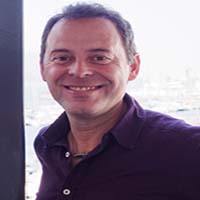
Speaker: Prof. Cesare Alippi, FIEEE, Information Processing Systems, Dipartimento di Elettronica, Informazione e Bioingegneria, Politecnico di Milano, Milano, Italy
Title: Intelligence in the cyber-physical revolution
Abstract: The emergence of non-trivial embedded sensor units and cyber-physical systems has made possible the design and implementation of sophisticated applications where large amounts of real-time data are collected, possibly to constitute a big data picture as time passes. Within this framework, intelligence mechanisms play a key role to provide systems with advanced functionalities. Intelligent mechanisms are needed to guarantee appropriate performances within an evolving, time invariant environment, optimally harvest and manage the residual energy, identify faults within a model-free framework, solve the compromise between output accuracy and computational complexity. The talk will show how the above aspects of intelligence are needed to boost the next generation of cyber-physical-based and Internet of Things applications, generation whose footprint is already around us.
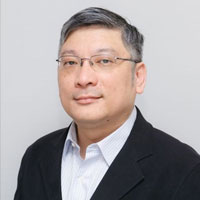
Speaker: Prof. Wai Ho MOW, Dept of Electronic & Computer Engineering, Hong Kong University of Science and Technology, Hong Kong
Title: PiCode: a Picturesque Two-Dimensional Barcode with Mobile Marketing Applications
Abstract: In recent years, 2D barcodes, such as QR codes, have been widely used as a ubiquitous gateway to access the content of the online cyber world from the offline physical world. In mobile marketing applications, barcode scanning has become the most popular way to disseminate advertisement content to potential customers. Unfortunately, the conventional 2D barcodes are often too obtrusive in their appearance for integrating into an aesthetically designed advertisement, especially for expensive branded products. In addition, they may not be very effective in engaging potential customers since human understandable visual information, such as a picture, is either completely absent or too small to see, before the barcode is successfully decoded. In this presentation, a novel picture-embedding 2D barcode, called PiCode, which mitigates these two limitations by equipping a scannable 2D barcode with a picturesque appearance. PiCode is designed with careful considerations on both the perceptual quality of the embedded image and the decoding robustness of the encoded message. Comparisons with the existing beautified 2D barcodes show that PiCode achieves one of the best perceptual qualities for the embedded image, and maintains a better tradeoff between image quality and decoding robustness in various application scenarios. PiCode has been implemented in the form of a mobile application software in both the Android and iOS platforms. The practicality of PiCode has been successfully demonstrated in several real-world exhibition events in Hong Kong.
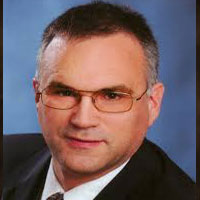
Speaker: Prof. Christian Langen, Hochschule Karlsruhe - Technik und Wirtschaft, Faculty of Electrical Engineering and Information Technology, Karlsruhe University of Applied Sciences, Germany
Title: Efficient Audio Coding for Ultra Low Latency by Iterative Symmetical Interpolation Wavelets
Abstract: To achieve psychoacoustically transparent digital wireless transmission of microphone signals with a data rate of 200kb/s data compression of 4:1 is required with a maximum signal latency time of 2ms for the entire coding process.
The signal variances in various frequency bands are analyzed by interpolation Deslauriers-Dubuc wavelets in a constant data stream that can be implemented efficiently by a multirate polyphase system with critical downsampling. Audio signals with Laplacian amplitude variance statistics can be decorrelated using this method to make lossless data compression possible.
The actual data compression is done by variable bit allocation in dependence of the signal amplitude variances in the individual frequency bands using the "Greedy Bit Allocation" algorithm that yields a constant quantization error over all frequency bands independently of the individual signal amplitude variances for a constant overall data rate.
Measurements of the objective quaintly and subjective comparing listening tests for evaluation are done to compare the quality to that of available reference encoders/decoders (codecs).

Speaker: Prof. Boaz Rafaely, Department of Electrical and Computer Engineering, Ben-Gurion University of the Negev, Israel
Title: Speaker localization under reverberation and noise
Abstract: Speaker localization is important for applications of audio signal processing, including speech communication, video conferencing and robot audition. Most current methods use microphone arrays and information based on the expected phase and amplitude differences between microphones as a function of the wave arrival direction. However, in rooms with reverberation, the direct sound is contaminated by reflections and localization typically fails. Recently, a reverberation-robust localization method was proposed for spherical microphone arrays, which uses only the direct-path bins in the short-time Fourier transform of the speech signals. These bins are selected according to the ratio between the first two singular values of the spatial spectrum matrix. Then, the direction-of-arrival at each selected bin is estimated using the MUSIC algorithm, formulated in the spherical harmonics domain. The collection of estimated directions for all selected bins is classified using Gaussian mixture model, and the speaker direction is computed as the mean of the dominant Gaussian. With this approach, correct speaker localization can be performed even under high levels of reverberation and noise, and for relatively long distances between the speaker and the microphone array. This talk will present the theory of the method, illustrating its performance using simulated and experimental data.
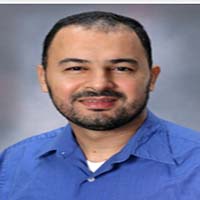
Speaker: Prof. Houssain Kettani, Professor, Department of Computer Science, Florida Polytechnic University, USA
Title: Towards Exascale Computing
Abstract: Due to hardware limitations, parallel computing became an integral part of our lives that it is hard to imagine a device that is not using multiprocessor power, including smartphones. What started as a hardware solution to physical limitation, prompted software engineers to adopt to parallelism. This in turn, compelled theoretical computer scientists to develop theoretical solutions to algorithms design and analysis to provide a solution that is parallel oriented rather than a serial oriented one, using divide-and-conquer algorithm design technique. Due to the exponential growth in high performance computing, the fastest computer in the world is projected to run at one Exaflop/s by 2020, or 1018 operation/second, ushering the era of exascale computing. As we move towards exascale computing and beyond, we need to keep in mind that the power of humanity is not in the powerful machines we develop, but remains in our intelligence and ability to develop solutions to problems at the basic level.
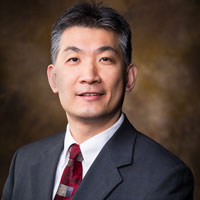
Speaker: Dr. Jia Di, Professor and 21st Century Research Leadership Chair, Department of Computer Science and Computer Engineering, University of Arkansas, USA
Title: Challenges and Opportunities of Asynchronous Circuits
Abstract: Different from the prevailing synchronous counterparts, asynchronous circuits do not have clock; instead, these circuits rely on handshaking protocols to coordinate the circuit behavior. This fundamental difference induces a set of advantages and disadvantages, which in turn grant asynchronous circuits challenges and opportunities. Although in the past years, the development of asynchronous circuits has lagged behind that of the synchronous counterparts, recent research and practices have developed technologies and identified applications for asynchronous circuits to make best use of their advantages and avoid the disadvantages, which will be introduced in this talk.
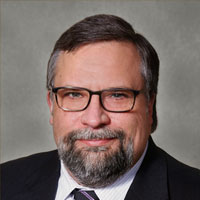
Speaker: Dr. Bruce Montgomery, Department of Electrical, Computer and Energy Engineering, University of Colorado Boulder, USA
Title: Methods for Designing Embedded Interfaces to People and to Things
Abstract: The ever increasing presence of embedded devices and systems for the broad range of Internet of Things (IoT) applications and for interaction with people during most activities of daily living is obvious. The typical skills of electrical engineers who design and develop such devices focus on the embedded devices themselves - example topics might include memory management, embedded system architectures, firmware designs, schematic and layout design, power handling, and use of test equipment. But in practice, embedded devices are rarely designed to be standalone; systems are developed through interfaces to other devices (machine-to-machine or M2M), to IoT networks, to the Cloud, and often directly to users for interaction. Also in practice, methods for rapidly prototyping to iterate through refinement of system elements and interface choices becomes a key skill for effective embedded design. This talk focuses on approaches for effective user experience, IoT and M2M interfaces, and rapid prototyping of embedded devices and systems. Usability and user experience design approaches and elements are presented specific to embedded systems concerns, including focused design approaches for popular applications such as wearables and voice interfaces. Wired and wireless M2M protocols are reviewed to differentiate capabilities and to illustrate selection methods. Approaches, architectures, and applications of IoT and Cloud technologies to embedded system design are also presented. The talk also reviews projects and design processes provided to accelerate rapid system prototyping. Finally the talk will look at how these methods have been presented to graduate electrical engineers through a newly developed class, Embedded Interface Design, for the University of Colorado Boulder's embedded systems engineering program, providing graduate students with new and broader perspectives on design practices and processes. By presenting these methods and processes, it is hoped that others may see opportunities and benefits in pursuing similar design topics within education, research, or in their own design activities.

Speaker: Dr. Yatabe, Research and Development Center for Taste and Odor Sensing, Graduate School of Information Science and Electrical Engineering, Kyushu University, Japan
Title: Taste Sensor and Odor Sensor
Abstract: The human has five senses, which are touch, hearing, eyesight, taste, and smell. Touch, hearing, and eyesight are classified into physical sense. Sensors for physical senses have been realized as touch sensor, microphone, and camera. On the other hand, taste and smell are classified into chemical sense. Although the development of chemical sensors have been carried out, there are few chemical sensors as practical in real situation. We introduce some sensors for taste and odor sensing. First, we introduce a taste sensor using lipid/polymer membrane. The taste sensor can measure the five basic taste qualities (saltiness, sweetness, bitterness, sourness, and umami). The taste sensor system has each sensor membranes corresponding to the five basic tastes. The taste sensor system can evaluate the taste of food or medicine due to measuring the electric potential of these sensor membranes. Second, we introduce an odor sensor to detect explosive compounds. The odor sensor can detect TNT (one of the most popular explosive compounds) with high sensitivity and selectivity using surface plasmon resonance sensor and antigen-antibody immunoreaction.
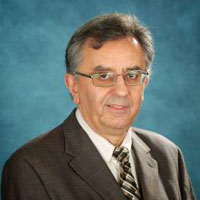
Speaker: Prof. Sousa E S, Electrical & Computer Engineering, University of Toronto, Canada
Title: Two-Tier 5G and Beyond Cellular Networks
Abstract: This talk will focus on a paradigm for 5G cellular networks centered on the concept of a two-tier network structure. The two-tier network consists of a set of deployed transceiver structures that act as terminals to the base classical stations/access points and relay communications to nearby user terminals based on use-case scenarios. This concept of two-tier can be looked at from different standpoints including that of classical relays, user transceiver antenna offloading, public/private physical network layering, or primary/secondary base stations. We give a point of that is system centric and present it as a fundamental architecture for 5G. The talk will discuss the concept as a complement to the deployment of small cells to achieve the required future network capacities. The concept is strongly dependent on the utilization of massive MIMO. We discuss some of the optimization problems in interference management, emerging concepts of massive channel estimation, and what we refer to as massive coding.

Speaker: Prof. Edward A. Lee, Robert S. Pepper Distinguished Professor, EECS Department, University of California, Berkeley, USA
Title: A Personal View of Real-Time Computing
Abstract: Today, real-time behavior of programs is a property that emerges from implementations rather than a property that is specified in models. Control over timing behavior of software is difficult to achieve, and timing behavior is neither predictable nor repeatable. The recently exposed Meltdown and Spectre vulnerabilities also reveal that uncontrolled timing of programs compromises security. I will argue that these problems can be solved by making a commitment to deterministic models that embrace temporal properties as an integral part of the modeling paradigm for programs. I will show moreover that deterministic timing is practical today without sacrificing performance for many useful workload models. Specifically, I will describe a class of computer architectures called PRET Machines that deliver deterministic timing with no loss of performance for a family of real-time problems consisting of sporadic event streams with hard deadlines.

Speaker: Prof. Brian Barsky, Computer Science Division School of Optometry, Berkeley Center for New Media, Berkeley Institute of Design Arts Research Center, Berkeley University of California, Berkeley, USA
Title: Computational Optometry and Ophthalmology
Abstract: This talk will present a retrospective of our work in computational optometry in which novel methods have been developed to address problems in optometry and ophthalmology. Cornea topography and videokeratography measure the shape of the cornea. Using spline surface fitting of normal vectors, we developed a mathematical reconstruction algorithm to describe the shape of the surface of the cornea from secular reflection patterns. This enabled the development of a method of computer-aided contact lens design and fabrication using spline- based mathematical surfaces without restrictions of rotational symmetry. It also spawned the development of the CWhatUC visual acuity simulator. Subsequently, we developed Vision Realistic Rendering, a computer graphics technique to simulate vision by generating images that demonstrate the vision of a patient based on actual patient data measured by a Shack-Hartmann wavefront aberrometer. The images are rendered by blurring a set of depth images. High quality depth of field blurring is used to improve both the accuracy and speed of the simulation. We generate a smooth wavefront surface from this sparse set of samples. Our wavefront surface is a fifth-degree Zernike polynomial bivariate surface defined as a height field whose domain is the pupil plane. The polynomial is determined by a least squares fit to the Shack-Hartmann data. This provides a continuous surface, allowing us to sample the wavefront at a much higher rate. Examples will be shown of simulations using data measured from individuals with high myopia (near-sightedness), astigmatism, and keratoconus, as well as simulations based on measurements obtained before and after corneal refractive (LASIK) surgery. Recent work on vision-correcting displays will also be discussed. Given the measurements of the optical aberrations of a user’s eye, a vision correcting display will present a transformed image that when viewed by this individual will appear in sharp focus. This could impact computer monitors, laptops, tablets, and mobile phones. One of the potential applications of possible interest is a heads-up display that would enable a driver or pilot to read the instruments and gauges with his or her lens still focused for the far distance. Vision correction could be provided in some cases where eyeglassses are ineffective.
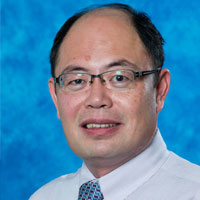
Speaker: Prof. Chin-Tser Huang, Department of Computer Science and Engineering, Global Carolina Regional Director of China and Taiwan, University of South Carolina, USA
Title: Detecting Malicious Traffic and Malware Hidden in the Internet
Abstract: As the popularity of Internet keeps growing, it has become a very dangerous place where objects of malicious contents injected by cybercriminals can be hidden in plain sight and under delicate disguise. In this talk, we introduce different ways to detect and capture these malicious contents hidden in the Internet. In the first part of this talk, we consider the detection of malicious traffic. Malicious communication generated by malware is indicative of its presence. In the case of botnets, their command and control (C&C) communications are valuable targets of detection efforts. Among the widely used C&C protocols, HTTP is becoming one of the most favorite. However, detecting HTTP-based C&C packets that constitute only a minuscule portion of the overwhelming amount of HTTP traffic is a challenging task. We present an anomaly detection based approach to detect HTTP-based C&C traffic using statistical features based on client-generated HTTP request packets and DNS server generated response packets. In the second part of this talk, we consider the detection of malware. The online multi-AV scanning service VirusTotal is widely used to scan and analyze the samples, but it can only generate an aggregation of antivirus scan reports. We need a multi-scanner solution that can accurately determine the maliciousness of a given sample. We introduce three theoretical models, which enable us to predict the accuracy levels of different combination of scanners and determine the optimum configuration of a multi-scanner detection system to achieve maximum accuracy.
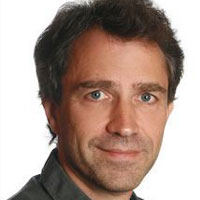
Speaker: Prof. Dr. Michael Vorlander, Director, ITA - Institute of Technical Acoustics, RWTH Aachen University, Aachen, Germany
Title: Signal processing for Virtual Acoustic Environments
Abstract: Acoustic simulation and auralization techniques are widely used in engineering, architecture, sound design and in applications in hearing research. The main features of this technique are acoustic source and propagation simulations and corresponding real-time signal processing tools. The most important challenges are lack of data of 3D characterization of sound sources and acoustic material parameters, and robust interfaces to spatial audio technology. In this paper the processing steps for creation of Virtual Acoustic Environments are introduced and discussed. The achievable degree of realism is evaluated in examples.

Speaker: Prof. Chilukuri K. Mohan Professor, Dept. of EECS, Center for Science and Technology, Syracuse University, NY, USA
Title: Anomaly Detection with Social Media Data
Abstract: Large amounts of data available on social media can be analyzed in various ways, depending on the application goals; for example, target marketing efforts have been actively pursued by multiple researchers and organizations. This talk focuses on the application of anomaly detection algorithms to social media data, discussing two examples in detail. Of particular interest is the analysis of changes in behaviors of individuals with time, and how such changes may be reflected in social media data, and hence inferred from the same. The various kinds of anomaly detection algorithms are first surveyed, discussing the contexts of their applicability for social media data.

Speaker: Dr. Wenwu Wang, Centre for Vision Speech and Signal Processing, Department of Electronic Engineering, University of Surrey ,Guildford, United Kingdom
Title: Bayesian Filtering for Audio-Visual Multi-Source Tracking
Abstract: The problem of detection and tracking of multiple moving speakers in indoor environments using audio-visual (AV) modalities has attracted an increasing amount of attention in the last decade due to its potential applications in e.g. automatic camera steering in video conferencing, individual speaker discrimination in multi-speaker environments, and surveillance and monitoring in security applications. Several challenges are associated with AV tracking including fusion of multi modalities, estimation of the variable number of speakers and their states, and dealing with various conditions such as occlusion, limited view of cameras, illumination change and room reverberations. This talk presents some recent and new development for addressing part of these challenges under the Bayesian framework. In particular, we present an adaptive particle filtering algorithm, PHD filtering algorithm and sparse-sampling based PHD filtering algorithms.

Speaker: Prof. Christelle Scharff, Seidenberg School of Computer Science and Information Systems, Chairperson of Computer Science, Pace University, USA
Title: Mixing Continents, Skills, Roles and Tools: Lessons Learned from Ten Years of Global Software Engineering Education
Abstract: This presentation details ten years of a software engineering education initiative led by Pace University in New York City that brought together students and faculty from x countries, including India, Cambodia, Thailand, Tanzania, and Senegal, to work and fulfill different roles on globally distributed software development projects. The work provided students with skills and international exposure crucial for joining today’s job market. Different models of student collaboration were examined and various research focus ranging from processes, tooling infrastructures, to entrepreneurial opportunities were emphasized.
The presentation will give an overview of the educational initiative, explain its evolution, and summarize the key lessons learned from the perspectives of students and instructors. It will provide useful resources for instructors and institutions interested in embarking on such initiatives.
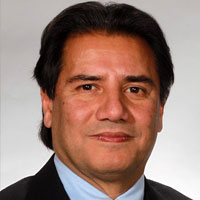
Speaker: Prof. Hamid Sharif, Ph.D., IEEE Fellow, Charles Vranek Distinguished Professor, Director, Advanced Telecommunications Engineering Laboratory (TEL), Electrical and Computer Engineering Department, College of Engineering, University of Nebraska–Lincoln, USA
Title: Wireless Communication Challenges in Rail Transportation Applications
Abstract: Advances in wireless communication technologies have enabled the new Intelligent Transport System (ITS) applications for effective and reliable surface transportation to control mobility, safety, and security of transportation. In the rail environment, wireless communication plays a critical role in monitoring and controlling trains and railcars. For the freight rail industry, the inter- and intra- railcar communications offer difficult wireless technology challenges due to the linear topology of over a large number of railcars, typically around 100 railcars in a freight train, dynamic nature of RF channels and interferences, and the topography of rail tracks. This requires reliable wireless technologies to support time critical applications. The challenges in passenger trains are also broad including the high-speed train’s wireless communications with consideration of signal fading and path loss due to the train’s high velocity. Dr. Sharif will discuss research trends and different wireless technology challenges for supporting communications in different modes of surface transportation with time critical applications and data intensive traffic. This includes the presentation of a newly developed technology called Hybrid Technology Networking (HTN) to provide communications in a real-time railcar monitoring system to address a critical shortcoming identified in the de-facto standard in wireless sensor networks.
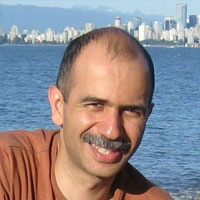
Speaker: Prof. Shahriar Mirabbasi, Department of Electrical and Computer Engineering, University of British Columbia, Vancouver, Canada
Title: Techniques for Efficient On-Chip mm-Wave and (Sub-)THz Signal Generation in CMOS
Abstract: The mm-wave and (sub-)THz bands are gaining popularity due to their less populated spectrum and availability of wider bandwidths. Furthermore, operating at such frequencies enables interesting applications in various fields including spectroscopy, imaging, and sensing. Nevertheless, on-chip generation of such frequencies, especially when using the mainstream CMOS technologies is challenging due to the limitations of the technology. In this talk, we present some of the main implementation challenges as well as techniques to overcome such challenges and efficiently generate (sub-)THz signals using the low-cost and versatile CMOS technologies.
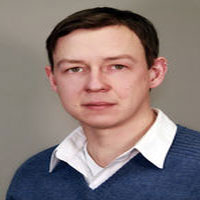
Speaker: Prof. Dr. Sven-Hendrik Voß, Beuth Hochschule für Technik Berlin, University of Applied Sciences, Berlin, Germany
Title: Low-Latency FPGA acceleration in modern designs
Abstract: As the current trend towards high-performance seeks for even larger memory capacity, lower access latency, higher bandwidth, and lower power the modern hardware design approach is strongly trending towards heterogeneous system designs, where portions of demanding applications can be offloaded to hardware accelerators. The use of FPGAs (Field Programmable Gate Arrays) provides specific reconfigurable hardware technology that can be properly exploited to build flexible high-performance systems by performing very specific functions in hardware at comparatively very low-power consumption. Architectural characteristics like enormous parallelism, on-chip memory, integrated DSP cores, etc. contribute to the high efficiency in implementing highly demanding tasks.
However, there are still some challenges to be solved to gain full benefit of FPGA-accelerated systems. Most applications need to be modified and re-structured to fully take advantage of the massive parallelism of the FPGAs. Algorithms need to be re-partitioned or re-designed with respect to hardware/software co-design techniques. Besides, new abstractions are needed to make system development effective and powerful.
This talk, after a brief history of hardware/software co-design, touches upon a number of performance issues and then focuses on architecture concepts for high-performance systems comprising hardware and software elements. In this context the approach of high-level synthesis (HLS) - promising shorter design cycle compared to handwritten RTL designs - is explored and the potential and limitations are identified. A review of recent developments in FPGA implementations is presented, describing the employed FPGA resources as well as providing an overview of future research within this field.
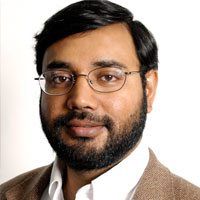
Speaker: Prof. M. Iftekharuddin Khan Associate Dean for Research and Graduate Program Batten College of Engineering and Technology Director, Vision Lab, Old Dominion University, USA
Title: Contemporary deep learning for pattern recognition
Abstract: Deep learning has revolutionized the use of artificial neural networks (ANNs) in complex applications such as computer vision, speech recognition, and bioinformatics. Deep learning essentially enables autonomous learning of multi-layered (deep) large scale neural networks using large scale data. The cascading of many layers in deep architectures, as opposed to shallow structure of the network, facilitates the hierarchical feature learning and transformations in ANNs. The organization and workings of deep neural networks (DNNs) mimics the overall working principle of neural pathways observed in the biological vision system. This talk outlines the latest research in the Vision Lab at Old Dominion University on improving deep architectures by incorporating simultaneous recurrent connections, another desired characteristics that is ubiquitous in the primate vision system, for pattern recognition. We will also discuss our current works in deep learning with less data.

Speaker: Prof. Ian White, Electrical Engineering Division, Cambridge University, UK
Title: Large Port Count High Speed Optical Switches for Packet Routing Applications
Abstract: The rapidly growing complexity of optical networks is leading to renewed interest in optical switches for high speed routing applications. This paper will first review the advances of the field in recent years. It will then describe the performance of a hybrid optical switch which uses both interferometers and semiconductor optical amplifiers to provide routing with low insertion loss and low crosstalk. These properties are important to ensure that a large number of ports can be accommodated. The paper will report how the use of dual Mach Zehnder Interferometer – Semiconductor Optical Amplifier switches with a Clos-Beneš architecture can achieve a record 2048 port count.

Speaker: Dr. Teruaki Hayashi, Department of Systems Innovation, School of Engineering, The University of Tokyo, Japan
Title: Knowledge Structuring for Cross-discipline Data Exchange and Utilization
Abstract: Throughout history, human beings have acquired and used various kinds of data in decision making. In recent years, the potential benefits of reusing and analyzing massive amounts of data have been discussed by various stakeholders from diverse domains. However, it is difficult to learn the kinds of data that are related to our interests as well as the means to obtain and utilize them. Moreover, the discussion involves privacy and security of data. To tackle the problems, we have developed the techniques for sharing information and knowledge pertaining to data and the platform for discussing the potential value of datasets. The Data Jacket (DJ) is one the solutions. The idea underlying the DJ is to share "a summary of data" as metadata without sharing the data itself, which enables stakeholders in terms of data utilization to discuss the combinations of data. Metadata is conventionally a data description format for enhancing the readability of machines. On the contrary, the DJ is a method for describing summarized information about data for humans to read and understand the utility of data. In this invited talk, I introduce our latest technologies for activating cross-discipline data exchange and utilization from the viewpoint of an interactive visualization and retrieval system by structuring the knowledge of data utilization.

Speaker: Dr. Roger Giddings, School of Electronic Engineering, Bangor University, Bangor, United Kingdom
Title: DSP-enabled Cloud Access Networks
Abstract: To meet the demands of the rapidly growing and diverse range of internet services, future optical networks must not only provide higher capacity connections but must become highly dynamic and adaptive offering reconfigurable and flexible network interconnectivity that can efficiently utilize network resources according to the prevailing traffic demand. The seamless convergence of fixed and mobile networks into a software defined networking (SDN) controlled cloud access network (CAN) is a highly promising solution for meeting the future network demands. Digital signal processing (DSP) is a key enabling technology for realising intelligent network solutions that can deliver the adaptive, flexible and highly reconfigurable CANs in a highly cost-effective manner. This talk presents some of the recent work by Bangor University on DSP-based cloud access networks. We have proposed a DSP-based technique which supports multiple virtual channels on a single optical wavelength which are transparent to factors such as signal modulation format, channel bandwidth, signal detection scheme, network topology and multiple access technique. We have also proposed and investigated the associated smart network devices for implementing CANs, such as reconfigurable optical transceivers, reconfigurable optical add/drop multiplexers (ROADMs) and spectral converters, furthermore we have also performed a number of experimental demonstrations employing FPGA-based real-time DSP to validate the techniques.
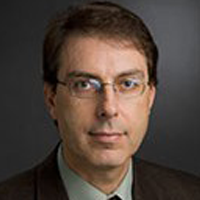
Speaker: Prof. Andreas Savakis, Professor of Computer Engineering, Rochester Institute of Technology, USA
Title: Adaptive Deep Learning for Computer Vision Applications
Abstract: Deep learning has revolutionized all aspects of computer vision, including object class recognition, face recognition, semantic segmentation, scene analysis, pose estimation, object tracking, image captioning etc. This talk will overview the impact of deep learning in computer vision applications and will focus on the adaptation of deep networks for object detection. Classifier performance often suffers due to variations between source (training) and target (testing) domains, a problem known as the dataset bias. Domain adaptation methods aim to overcome this limitation. We discuss a novel domain adaptation approach for deep learning that performs unsupervised label transfer from the source domain to the target samples for updating the network. Our approach utilizes Adaptive Batch Normalization to produce a common feature-space between domains. We perform label transfer based on subspace alignment and k-means clustering on the feature manifold to transfer labels from the closest source cluster to each target cluster. This method produces state-of-the-art results for deep adaptation on digit recognition datasets.
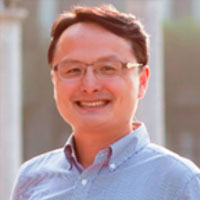
Speaker: Dr. Chuan-Yu Chang, Distinguished Professor, Department of Computer Science and Information Engineering, Dean, Research and Development, National Yunlin University of Science and Technology, Taiwan
Title: Infant Crying Detection and Analysis
Abstract: Crying is the way that infants express their needs to their parents. Before learning how to express the emotions or physiological/ psychological requirements with language, infants usually express how they feel to parents through crying. Parents often feel worried and anxious when infant crying. To accurately determine the meanings of the newborn cries, we proposed a novel method that constructs personalize crying models for different infants. Experimental results have revealed good performance of the proposed system.
Invited talk of SPIN 2017

Speaker: Prof. Brian Barsky, Computer Science Division School of Optometry, Berkeley Center for New Media, Berkeley Institute of Design Arts Research Center, Berkeley University of California, Berkeley, USA
Title: From Vision-Realistic Rendering to Vision Correcting Displays
Abstract: Present research on simulating human vision and on vision correcting displays that compensate for the optical aberrations in the viewer's eyes will be discussed. The simulation is not an abstract model but incorporates real measurements of a particular individual’s entire optical system. In its simplest form, these measurements can be the individual's eyeglasses prescription; beyond that, more detailed measurements can be obtained using an instrument that captures the individual's wavefront aberrations. Using these measurements, synthetics images are generated. This process modifies input images to simulate the appearance of the scene for the individual. Examples will be shown of simulations using data measured from individuals with high myopia (near- sightedness), astigmatism, and keratoconus, as well as simulations based on measurements obtained before and after corneal refractive (LASIK) surgery.
Recent work on vision-correcting displays will also be discussed. Given the measurements of the optical aberrations of a user’s eye, a vision correcting display will present a transformed image that when viewed by this individual will appear in sharp focus. This could impact computer monitors, laptops, tablets, and mobile phones. Vision correction could be provided in some cases where spectacles are ineffective. One of the potential applications of possible interest is a heads-up display that would enable a driver or pilot to read the instruments and gauges with his or her lens still focused for the far distance.

Speaker: Prof. Alfredo Rosado Munoz, ETSE, GPDD, Department of Ingenieria Electronica, Universidad de Valencia, SPAIN
Title: Hardware architectures for real-time signal processing computations
Abstract: With growing computation demands in real-time classification, prediction and signal processing in general, algorithms become more complex while low power and small size devices are required for real-time architectures. Matrix operations are common for such computation algorithms and, in numerous algorithms, it is also required to perform matrix operations repeatedly, where the result of an operation is further operated again. On the other hand, FPGA devices are very common in real-time hardware implementations. These devices contain specific blocks devoted for signal processing algorithms (DSP-MAC units, distributed RAM, etc.). It is not a common approach to suit algorithms to existing device resources, but doing this allows to optimize resources and performance. With this view, we will describe different architectures and topologies well suited for real time implementation: a universal neural network computation architecture, neural network on-chip training algorithm(ELM and OS-ELM), matrix computations (addition, subtraction, dot product, multiplication, inversion), restricted Boltzmann Machines (RBM), and spike-based bioinspired processing systems). We show the hardware architectures and examples showing the high capacity of the proposal, allowing up to 2000 neurons neural network. implementations, or 1000x1000 matrix operations working at clock rates higher than 250MHz.

Speaker: Prof. Jae Hong Lee, Dept. of Electrical and Computer Engineering, Seoul National University, Seoul, Korea
Title: Cognitive Radio for Wireless Communications: Concepts and Applications
Abstract: To meet rapidly growing traffic demands and accommodate large number of devices, more radio spectrum is needed for future wireless communications. Considering the scarcity of radio spectrum, it is needed to enhance the utilization of radio spectrum licensed exclusively to specific users. In cognitive radio, an unlicensed user, called a secondary user, is permitted to access the spectrum allocated to a licensed user, called a primary user. When the primary and secondary users transmit their signals simultaneously, interference occurs at both users which degrades their performance. Interference at the primary user can be avoided by spectrum sensing technique which prohibits a secondary user from transmitting its signal when it detects a primary user’s signal. Also, interference level at the primary user can be limited below a certain threshold by spectrum sharing technique in which the secondary user adjusts its transmit power accordingly. Some recent results on cognitive radio are introduced, and its applications and future research subjects are shown.

Speaker:Prof. King Ngi Ngan, Chair Professor, Department of Electronic Engineering, The Chinese University of Hong Kong, Hong Kong
Title: 3D Morphable Model and its Applications
Abstract: In this talk, the research work on 3D morphable model and its applications conducted in the Image and Visual Processing (IVP) Laboratory of the Chinese University of Hong Kong (CUHK) is discussed. The 3D morphable model is introduced with respect to the works carried for face and body reconstruction. It applications to head pose tracking,facial expression tracking,face reconstruction using a single color image, and human body reconstruction are explored. Demonstrations showing the results obtained are displayed in video. Lastly some future directions will be outlined

Speaker: Prof. Yusuke Tahara, Graduate School of Information Science and Electrical Engineering Kyushu University, Japan
Title: Taste Sensor with Lipid/polymer Membranes
Abstract: The human taste receptors do not necessarily recognize individual chemical substances. Each of the receptors for the five basic taste qualities (saltiness, sweetness, bitterness, sourness, umami) simultaneously receives multiple chemical substances. It means the human gustatory receptors have a semi-selective property or global selectivity. Sensory evaluation, in which experienced evaluators called sensory panelists actually taste samples to evaluate them,has been made to estimate the tastes of samples so far. This method has several problems such as low objectivity, low reproducibility, the stress possibly imposed on panelists and the significant cost of selecting and training panelists. It is difficult to carry out sensory evaluations because of the potential for medication side effects in the medical and pharmaceutical field.The presentation will focus on the recent developments in a“taste sensor”, i.e., electronic tong with global sensitivity based on membrane potential changes of lipid/polymer membranesfor taste evaluation of foods, beverages and pharmaceuticals.The taste sensor hasbeen developed to realize a sensor that responds to taste chemical substances and can be used to quantify the type of taste focusing on the fact that humans discriminate the taste of foods and beverages on the tongue on the basis of the five basic tastes.

Speaker:Dr. Javier Barria, Reader, Department of Electrical and Electronic Engineering Imperial College, London, UK
Title: On-line time series classification with application to anomaly detection
Abstract: In this talk recent research output on a domain-independent temporal data representation framework will be highlighted [1]. The novel data representation framework, named Structural Generative Descriptions (SGDs), is based on a novel data representation strategy that combines structural and statistical pattern recognition approaches, the key idea being to move the structural pattern recognition problem to the probability domain. The framework consists of three tasks: a) decomposing input temporal patterns into sub-patterns in time or any other transformed domain, b) mapping these sub-patterns into the probability domain to find attributes of elemental probability sub-patterns called primitives, and c) mining the input temporal patterns according to the attributes of their corresponding probability domain sub-patterns. Two off-line and two on-line algorithmic instantiations of the proposed SGD framework will be briefly highlighted. The empirical evaluation of the proposed SGD-based algorithms will be summarised in the context of time series classification for off-line algorithms, and in the context of change detection for on-line algorithms. The talk will also highlight real world applications, where the intrinsic domain independent nature of the proposed SGD framework can be used: i) biometric recognition and forensics, ii) smart infrastructures monitoring, iii) machine/motor health conditioning monitoring, iv) transportation networks monitoring and, v) environmental (pollution) monitoring.

Speaker: Dr. Roland Petrasch - Professor, Beuth University of Applied Sciences Berlin - University of Applied Sciences, Berlin, Germany
Title: From Computer & Communication Networks to Software-Defined Infrastructures and Smart Cloud Applications
Abstract: Software and Platforms as a Service (SaaS, PaaS) in the era of Software-Defined Networking (SDN) and Cloud Computing (CC) found its way into practice. But what comes next? This talk discusses aspects of the so-called Software-Defined Infrastructures (SDI) and the new idea of Smart Cloud Applications (SCA) where a holistic approach leads to intelligent software-supported business processes with access to an integrated data base connecting raw IoT data with ERP/CRM data models in a Cloud Storage Hub (CSH) that are managed by Artificial Intelligence (AI) and Knowledge Management (KM) components.

Speaker: Prof. Zoran Ivanovski, Faculty of Electrical Engineering and Information Technologies, Ss. Cyril and Methodius University in Skopje Republic of Macedonia
Title: ERROR SPOTTING: New Approach Towards Robust Super-Resolution and beyond
Abstract: Super-resolution (SR) algorithms are known to be very sensitive to errors in registration of the low resolution images, as well as presence of outliers. These registration errors and outliers introduce unpleasing to very annoying artifacts in the super-resolved image, rendering the SR procedure useless for practical purposes. The talk will focus on a novel idea for effective super-resolution robust to errors in the registration process. The main idea of the approach is to allow the SR process to introduce artifacts due to registration errors, to detect the locations of the artifacts and to efficiently suppress the cause for their appearance in the final SR procedure. The approach relies on efficient feature extraction and machine learning based artifacts detection. The idea is further developed and applied to the problem of accurate subpixel motion estimation for Super- resolution. The objective is to improve the quality of the SR image by increasing the accuracy of the motion vectors used in the SR procedure. This increased accuracy of the motion vectors is achieved based on visual appearance of error artifacts in the SR image, introduced due to registration errors. First, SR is performed using full pixel accuracy motion vectors obtained using any appropriate motion estimation algorithm. Then, a machine learning based method is applied on the resulting SR image in order to detect and classify artifacts introduced due to missing subpixel components of the motion vectors. The outcome of the classification is a subpixel component of the motion vector. In the final step, SR process is repeated using the corrected motion vectors.

Speaker: Prof. Waleed H. Abdulla, Deputy Head of Department (Research), Department of Electrical and Computer Engineering, The University of Auckland, New Zealand
Title: Human Biometrics: Value and Future
Abstract: The 2001 MIT Technology Review indicated that biometrics is one of the emerging technologies that will change the world. Human Biometric is automated recognition of a person using adherent distinctive physiological and/or involuntary behavioral features. Physiological features include facial characteristics, fingerprints, palm prints, iris patterns, and many more. Examples of behavioral features are signature, writing dynamics, gait, voice, and keyboard typing dynamics. The valid features used in any biometric approach must be quantifiable, robust and distinctive. Biometrics technology is initially treated as an exotic topic while recently it is a fast growing industry due to the urgent needs to secure people properties from goods to information. Biometric recognition comprises authentication and identification. However, the main need is for authentication. Authentication can be pursued by: Something You Own, Something You Memorize, and Something You Carry. Biometric is something that everyone owns and available at all times with the person, thus it will prevail. Despite all the advantages biometrics recognition facilitates, not all people support the use of biometrics. Biometrics proliferation for recognizing people raised concerns from the civil rights advocates. The issue of privacy is the big concern and where the privacy and security should meet. Also, the compromise of the biometrics data is one of the main concerns; what if someone manage to unlawfully attain the data? In this talk I will introduce the human biometrics topic and discuss several issues surrounding its proliferation and its future.

Speaker: Prof. Sri Krishnan, Associate Dean, Canada Research Chair, Ryerson University, Canada
Title: Connected HealthCare and Inspiring Opportunities
Abstract: This talk will provide a general overview of connected healthcare with some specific examples of research undertaken at Signal Analysis Research (SAR) group at Ryerson University, Canada. Connected Healthcare harnesses the power of sensors, information and communications technology, signal and data processing, analytics and machine learning for informed and better decision making in healthcare. With the emergence of Internet of Things (IoT), wearable and wireless sensing, real-time machine learning algorithms connected healthcare is expected to make a significant impact in the day to day lives of many people. It also paves way for tele-medicine and mobile health applications.

Speaker: Prof. António Dourado, University of Coimbra, Portugal, European Union
Title:Epileptic Seizures Prediction by EEG Signal Processing: Progresses and Challenges
Abstract:Epilepsy is a neurological disease affecting about 1% of the population, anywhere, at any age. About one third of these patients are insensitive to drug treatment or brain surgery, and these unfortunate people must leave daily with the possibility to have a seizure at any time. This fact imposes severe constrains and limitations to their lives. The possibility of seizures prediction by processing of the multichannel EEG signals has been and is the subject of extensive research worldwide. Many progresses have been reported, but serious challenges remain in order to have prediction algorithms with clinical acceptance, allowing the development of transportable devices capable of alarming the patient when a seizure is coming. Computational intelligence and machine learning are viewed nowadays as techniques that may contribute to good predictors. A review of these techniques will be made and the published results critically analyzed, namely those resulting from of the European FP7 Project EPILEPSIAE. Artificial Neural Networks and Support Vector Machines have been the main techniques extensively developed and tested for a sample of 275 patients of the European Epilepsy Database. The present challenges will be discussed, concerning algorithms, biosignals, and transportable devices. Due to the rapid development of powerful miniaturized hardware, it is expectable that substantial progresses will be made in the near future.

Speaker: Carlos M. Travieso-Gonzalez Vice-Dean,University of Las Palmas de Gran Canaria Institute for Technological Development and Innovation in Communications (IDeTIC) Signals and Communications Department, Campus Universitario de Tafira, s/n Pabelln B - Despacho 111, 35017 - Las Palmas de Gran Canaria, SPAIN
Title:Diagnostic aid system for neurodegenerative diseases
Abstract:The development of tools to aid diagnosis has been an important element in recent years to enhance research between technology and medicine. This has greatly facilitated the work of medical doctors and has made it possible to find greater efficiency in the health services of any country. Among the different medical specialties existing, is the Neurology. In particular, there has been collaboration during several years with the doctors of the “Dr. Negrín” University Hospital in Gran Canaria (Spain), in order to develop a non-invasive tool to obtain information about patients and to observe the evolution of the disease in them. We have worked with patients with Alzheimer's to observe the characteristic variations in loss of emotions. This diagnosis is one of the elements that doctors usually observe and allows them to have an opinion about their evolution. Therefore, a tool has been developed that captures this information (level of emotions or aurosal) with a webcam and informs the doctor in real time about the state of the patient's emotion. This tool can be used with and without the presence of the doctor and helps to decongest the patient lists, obtaining information from each patient under the recording protocol proposed by the medical doctor.

Speaker: Prof. Sotiris Skevoulis, Phd Professor Of Computer Science Seidenberg School Of CSIS, Pace University, USA
Title:Engineering Successful Partnerships Between Academia and Industry: Offering Customized Educational Programs to Industrial Partners
Abstract:The talk focuses on the opportunities and the challenges of such programs. It also suggests solutions to common problems found in developing and sustaining educational partnerships between Academia and Industry. In the past many such projects have started with great enthusiasm and support from both partners but soon they fainted and finally dissolved. The talk reflects on the strong and weak points of such partnerships. The goal is to ensure that the academic programs offered match the actual needs of the industrial partners by providing cutting edge technology transfer and customized training for their employees. A specific case study will be presented and analyzed, highlighting the key points of the keynote talk.

Speaker: Prof. Hsing Luh National Chengchi University, Taipei
Title:Computational Models for Priority Multi-Server Queues of Impatient Customers
Abstract:Considering high-priority and low-priority impatient customers, weconstruct a computational model for a Markovian system of multi-server queues. After an exponentially distributed duration with distinct rates in the system, both customers may abandon service and no return. In this presentation, the service time is assumed exponentially distributedfor all customers and service disciplines may be considered as First Come FirstServed (FCFS) or Last Come First Served (LCFS). By deriving the Laplacetransforms of the defined random variables and matrix geometric method with a direct truncation, we obtain an approximation to the stationarydistribution. We calculate the expected waiting time for both classesof customers. Given service and abandonment for each class of customers, we derive performance measures related to stationary probability distributions and conditional waiting times.

Speaker: Yi Qian, Professor Department of Electrical and Computer Engineering University of Nebraska-Lincoln
Title:Big Data, Cloud Computing and Smart Grid Communications
Abstract:In this talk, we explore a big data driven and cloud computing based information and communication technologies (ICT) framework for smart grid. Through the proposed framework, pricing forecast can be made to customers and energy forecast can be made to power generators. In addition, real-time monitoring and modern controlling can be applied to smart grid to prevent system failure or blackout. Advanced controlling is achieved by information gathered internally from smart grid through private networks deployed by utility companies, and external information from public sources through internet. Big data analytics is introduced so that useful information can be mined from collected data. Cloud computing is applied to perform big data analytics in the proposed ICT framework

Speaker: Jorma Skyttä, Professor, Electrical engineering, Department of Signal Processing and Acoustics, Aalto University, Finland
Title:Biometric feature detection from surveillance data using non-calibrated techniques
Abstract: The development of high quality video surveillance systems provides the ability to perform measurements from image data. This paper describes and demonstrates the extraction of basic human biometric features from surveillance video camera data using an uncalibrated single-view surveillance camera system. Perspective-based photogrammetric techniques are applied in situations where only minimal real world information is available. This information usually includes the reference height and two orthogonal sets of parallel lines on a reference plane. These all must be detectable both in the real world and be in the field-of-view of the camera. Using this type of setup, the orthogonal distance from the reference plane can be computed in any scene point. Measured biometric features include height and body dimensions. In addition the gait features and walking profile can be estimated when photogrammetry techniques are extended from single image to video stream. Such information can be used for forensic investigation and in various types of other applications where photogrammetric information is needed. This can be done without further information about the camera calibration or position.

Speaker: Professor A.H. Sadka, Director of Centre for Media Communications Research, Brunel University, London, England, UK
Title: Comparative performance evaluation of HEVC under error-free and error-prone conditions
Abstract: This research study presents a comparative analysis of the two most recent video coding standards, namely High Efficiency Video Coding (H.265|HEVC) and Advanced Video Coding (H.264|AVC). The experimental work is conducted on different video test sequences with various spatial resolutions and in an error free setting. In this work, the encoding efficiency of the HEVC algorithm is compared against that of H.264/AVC using the same encoding parameters for both standards in order to ensure fairness of comparison. The reference software used for H.265|HEVC codec is the HEVC Test Model (HM) Version 16.7, and for H.264|AVC the Joint Model (JM) version 19. The two codecs are compared using the objective quality metric (Y-PSNR). 200 frames of each sequence are tested, and the tests are carried out on computers with CPU Intel Xeon E3-1246 V3 @3.5 GHz, 8GB RAM, and Operating System Windows 7 Enterprise SP1- 64 bit;thecompilationof both codecs source codes is done using Microsoft Visual Studio 2013-64 bits. The obtained results show that H.265|HEVC encoder can achieve the same subjective quality as H.264|AVC encoder with 40%reduction in output bit rate. However, the Y-PSNR results show that the bit-rate saving in H.265|HEVC is decreased to around 15% for low spatial resolutions(176×144)and (352×288) video sequences. Furthermore, this study analyses and compares the error sensitivity (with noerror resilience)of both codecs. The bit error patterns are generated using network simulator version 3 (NS3), and injected in withloss rates ranging [0 -14]%. .

Speaker:Prof. K. Gopalan, Department of Electrical and Computer Engineering, Purdue University Northwest, Hammond, USA
Title:Audio Steganography and Watermarking for Information Hiding
Abstract: Information hiding and steganography are concerned with embedding information in a media (cover) signal in an imperceptible manner. Applications of steganography include watermarking for copyright protection and authentication, data hiding for secure storage and transmission, and covert communication using unclassified channels. Indiscernible hiding of information in an audio signal is more challenging than invisible modification of an image or video signal due to the wide dynamic range of human audibility in frequency and power level. In spite of this challenge, human auditory system imperfections, which lead to psychoacoustic masking effects in hearing and perception, can be exploited for unnoticeable modifying of a cover audio signal in accordance with a given piece of covert information. Since the modification is carried out in the masked regions of perceptibility, the information-embedded audio (stego) signal appears to be the same as the original signal in spectrogram and perceptual quality. Successful embedding depends, among others, on the discernibility of any difference between the original cover signal and the stego signal, robustness of the hidden information to noise, and recovery key that does not require the original cover audio signal. This talk will provide an overview of psychoacoustic masking-based audio steganography with an emphasis on the newly developed tone insertion techniques in the spectral and cepstral domains, and their extension to image embedding. Robustness of hidden data to noise and attacks, and quantitative measures for perceptual difference will also be discussed. A related waveform-domain steganography that indirectly relies on auditory masking property will be presented with its extension to hiding data on images.

Speaker:Dr. Kush Varshney, Mathematical Sciences Department, IBM T. J. Watson Research Center, USA.
Title: On Making Machine Learning Safe
Abstract: Machine learning algorithms are increasingly influencing our decisions and interacting with us in all parts of our daily lives. Therefore, just like for chemical plants, roads, vehicles, and myriad other systems, we must ensure that systems involving machine learning are safe. In this talk, we first discuss the definition of safety in terms of risk, epistemic uncertainty, and the harm incurred by unwanted outcomes. Then we examine dimensions along which certain real-world applications may not be completely amenable to the foundational principle of modern statistical machine learning: empirical risk minimization. In particular, we note an emerging dichotomy of applications: ones in which safety is important and risk minimization is not the complete story (we name these Type A applications), and ones in which safety is not so critical and risk minimization is sufficient (we name these Type B applications). Then, we discuss how four different strategies for achieving safety in engineering (inherently safe design, safety reserves, safe fail, and procedural safeguards) can be mapped to the machine learning context through interpretability and causality of predictive models, objectives beyond expected prediction accuracy, human involvement for labeling difficult or rare examples, and user experience design of software. Finally, we detail principled formulations for learning Boolean rule-based classifiers based on compressed sensing that are interpretable and therefore provide inherently safe design.

Speaker: Dr M. R. Swash, Department of Electronic and Computer Engineering, Brunel University London,UK
Title: Scalable Video Acquisition and Visualisation
Abstract: Imaging systems are widely utilised almost in all applications of entertainment, health, security and robotics. Due to explosive growth in end user devices of different sizes, resolutions and types, there is a great need of a scalable video imaging solution which serves the new generation of visualisation systems. This talks focuses on scalable video acquisition and visualisation, in particular Holoscopic 3D imaging system which is a true 3D imaging principle and offers a scalable digital images in both 2D and 3D image formats.

Speaker: Prof. Peter Bauer, Department of Electrical Engineering, College of Engineering, University of Notre Dame, USA
Title: A Set-Membership Method for Electric Vehicle Parameter Estimation
Abstract: A method for in-vehicle parameter estimation is introduced for EVs using set-membership estimation techniques. The goal is to estimate three key parameters that profoundly influence vehiclerange and health: wind speed, rolling resistance and overall powertrain efficiency. Especially the environmentally influenced parameters such as wind speed and rolling resistance are often highly uncertain and hard to measure directly, and thus are prime candidates for set membership estimationtechniques. Overall powertrain efficiency from power source to wheelsis also a quantity that is usual not easy to determine. In addition it is a key quantity that determines vehicle health. The paper also shows how consensus techniques in set membership estimation can provideuseful information for determining parameters that are shared by vehicles. The findings are illustrated using drive cycle simulations using the FTP75 urban cycle.

Speaker: Prof. Magdy A. Bayoumi, Director, Center of Advanced Computer Studies University of Louisiana at Lafayette, USA
Title: Brain on Silicon
Abstract: The brain has been always a mystery for humanity to figure out, the main question has been: can we read the brain? It may be a far fetched goal, but the road to solve has been fascinating. Brain Computer/Machine Interface (BCI/BMI) is one of the enabling technologies to reach this ultimate goal. BCI/BMI has a great potential for solving many physically challenged people's problems (e.g., restoring missing limb functionality) via neural- controlled implants. We have designed and developed a BCI chip that overcome the main challenges of low bandwidth communication, small chip area, low power, low heat dissipation, and tolerant to noise. The chip is adaptive and has simple architecture and circuits. The power consumption is reduced, but, and the accuracy of the system has improved up to 93.5% in the worst case. Depending on the application needs (Limb control application on mental disorder monitoring and detection), the proposed architecture could be use in an invasive closed-wound implant as well as a minimal invasive Implants. The proposed architecture was simulated in Matlab and implemented in Verilog, Modalism and Cadence. A case study of early prediction/warning and detection of epilepsy seisure will be illustrated.

Speaker: Prof. David A. Clifton, Group Leader - Computational Health Informatics (CHI) Laboratory, Fellow of Balliol College, Oxford University,UK
Title: Signal processing for the next generation of health informatics.
Abstract: Oxford is at the forefront of developing intelligent healthcare systems based on machine learning, including the world's first FDA-approved physiological monitoring systems based on machine learning, and research outputs that are now used to care for over 20,000 patients every month in the NHS. This talk introduces some of the methods and applications being developed at the Computational Health Informatics (CHI) Lab in the University of Oxford, which exploit "big data" approaches to machine learning that can obtain clinically-actionable information from fusing heterogeneous sources - including wearable sensors, electronic health records, and genomic/proteomic biomarkers.

Speaker: Prof. Rongqing Hui, Professor, Department of Electrical Engineering and Computer Science, University of Kansas, USA
Title: Digital subcarrier multiplexing for optical transmission and cross-connect switching
Abstract:With the rapid advance in high speed CMOS electronics, digital signal processing (DSP) becomes more and more popular in optical communication systems and networks. DSP is providing improved performance and flexibility in optical systems, and performing many functionalities previously considered only feasible in the optical domain. This presentation will discuss digital subcarrier multiplexing (DSCM) and its application in optical transmission and cross-connect switching. DSCM is a frequency domain multiplexing technique partitioning high speed data traffic into multiple digitally-generated orthogonal subcarriers without the need of spectral guard band between subcarriers. DSCM has the potential to provide high bandwidth efficiency, sub- wavelength spectral granularity for flexible circuit-based switching and interconnection, as well as the capability of electronic compensation of various transmission impairments. Digital-analog hybrid subcarrier multiplexing technique will also be which allows the increase of per-wavelength data rate while using relatively low-speed digital electronics.

Speaker:Dr. Mehmet Emir KOKSAL, Associate Professor , Ondukuz Mayis University, Turkey
Title:Signal Processing through Cascaded Networks and Commutativity
Abstract: Many of the signal processor systems are composed of successive treatment of signals by a chain connection of subsystems each of which is used to perform some part of a complete process. The sequence of processing is important to achieve the desired aim. It is determined by the system designer considering specific method of synthesis, environmental conditions, cost, durability, reliability, sensitivity, robustness, stability and many other engineering features of the processing device. In case of time-invariant subsystems, the order of them can be changed without affecting main functioning while achieving better performance characteristics. In case of time-varying case one cannot change the order of interconnection of two time-varying subsystems to arrive a better performance unless these sub systems are commutative. Otherwise the complete system losses its function and become useless. In this talk, after giving the general commutativity conditions and their applications to well-known second-order systems, results of numerical solutions of some commutative pairs are presented to emphasize role of commutativity to improve the performance characteristics.

Speaker: Prof. Ashfaq Khokhar, Professor and Chair, Department of Electrical and Computer Engineering (ECE), Illinois Institute of Technology (IIT), Chicago, USA
Title: Content-Aware Instantly Decodable Network Coding (IDNC) in D2D Networks
Abstract: Device-to-device (D2D) communication facilitates direct communication among smart devices without involving cellular infrastructure. Realizing its importance in emerging applications, D2D communication has also been provisioned in 5G specifications. In this talk, we explore Content-Aware IDNC for cooperative communication among cooperating mobile devices by taking into account the realistic constraints, such as strict deadline, bandwidth, or limited energy. Content-Aware IDNC exploits additional information about content, particularly when not all packets have the same importance and not all users are interested in the same quality of content. Content-Aware IDNC improves quality and network coding opportunities jointly by taking into account importance of each packet towards the desired quality of service (QoS). We will present different formulations of this problem and explore possible solutions. This work has been jointly pursued with: YasamanKeshtkarjahromi, HulyaSeferoglu, and Rashid Ansari (all at University of Illinois, Chicago) .
Invited talk of SPIN 2016

Speaker: Prof. Hui-Huang Hsu Department of Computer Science and Information Engineering. Tamkang University, Taiwan
Title: Recognizing Human Behavior via Smartphone Sensory Data
Abstract: Understanding the movement or even behavior of human requires various kinds of sensory data from wearable devices or environmental sensors. Nowadays, smartphones are equipped with sensors that can serve such a purpose. The most important thing is that people carry a smartphone most of the time. Therefore, comparing to other type of sensors, the smartphone seems to be an unobtrusive sensing device for the user. In this talk, we will first introduce general concepts. We will then discuss some of the possibilities. Results of selected research projects will also be presented.

Speaker: Prof. Alexander Kurganov Tulane University, LA, USA
Title: Central Schemes: A Powerful Black-Box Solver for Nonlinear Hyperbolic PDES
Abstract: Nonlinear hyperbolic PDEs arise in modeling a wide range of phenomena in physical, astrophysical, geophysical, meteorological, biological, chemical, financial, social and other scientific areas. Being equipped with efficient, accurate and robust numerical methods is absolutely necessary to make substantial progress in all of those fields of research. This talk will be focused on non-oscillatory central schemes, which can be used as a high-quality black-box solver for general hyperbolic systems of conservation laws. I will first briefly show their derivation, discuss some current developments, and then present several recent applications including modern network models of traffic and pedestrian flows, gas pipes, and dendritic river systems.

Speaker: Prof. Hsi-Pin Ma Department of Electrical Engineering, National Tsing Hua University, Taiwan 30013
Title: Wireless Healthcare: Electronics and Systems
Abstract: Helath is an emerging topic for healthcare systems. Based on the infrastructure of the mobile communications systems, the healthcare system can provide much more services. In this talk, a platform for mobile healthcare system is presented. The ECG/respiration monitoring is just an example. We can use the low complexity low power wireless sensor node to record the ECG signal and continuously monitor for a long time. By mobile phone, we can use the existing 3G/WiFi network to send back the recorded ECG signals for further analysis. There is no extra deployment cost for the whole infrastructure. We also proposed some algorithms for ECG signal analysis implemented both on the mobile phones and cloud. This can let doctors have more options to provide medical services. With the possibilities of wearable sensing techniques, we can also extend the techniques to the life style applications or interdisciplinary collaborations. Some demos will be presented within the talk

Speaker: Prof. Marius Pedersen Director of The Norwegian Colour and Visual Computing Laboratory, Faculty of Computer Science and Media Technology, Gjovik University College, Norway
Title: Towards a Perceptual Image Quality Metric
Abstract: The evaluation of image quality is a field of research that has gained attention for many decades. Since subjective evaluation of image quality is time-consuming and resource demanding, there is increasing effort to obtain a objective image quality metric capable of predicting perceived image quality. In this talk we give an overview of existing image quality metrics, and the advancements in the field towards obtaining a perceptual image quality metric. We focus specifically on image quality metrics that simulate the human visual system, and how well they are able to predict perceived image quality

Speaker: Prof. Henrik Hautop Lund, Professor Center for Playware, Technical University of Denmark
Title: Playful Modular Technology – Play with Networks of Radio Communicating Interactive Modules
Abstract: With recent technology development, we become able to exploit robotics and modern artificial intelligence (AI) to create playware in the form of intelligent hardware and software that creates play and playful experiences for users of all ages. Such playware technology acts as a play force which inspires and motivates you to enter into a play dynamics, in which you forget about time and place, and simultaneously become highly creative and increase your skills - cognitive, physical, and social skills. The Playware ABC concept will allow you to develop life-changing solutions for anybody, anywhere, anytime through building bodies and brains to allow people to construct, combine and create. Two decades of scientific studies of such playware in the form of playful robotics, LEGO robots for kids, minimal robot systems, user-friendly, behavior-based, biomimetic, modular robotics lead Prof. Lund’s students to form the Universal Robots company, which disrupted the industrial robotics sector, and recently was sold for 285 million USD. Another example of exploiting the playful and user-friendly technology development is the modular interactive tiles system, Moto tiles (www.mototiles.com), which is designed as an alternative form of physical rehabilitation exercise to allow elderly citizens and patients to break away from monotonous training programs, and participate in an exercise that is fun and exciting, and therefore more motivating. Qualitative studies show that therapists and elderly find the training with modular interactive tiles fun and highly motivating. Further, scientific studies have shown that training with the modular tiles has a large effect on the functional abilities of the elderly. The tests of effect show that training with the Moto tiles provides improvements on a broad range of abilities including mobility, agility, balancing, strength and endurance. The playful training improves the abilities of the elderly in many areas of high importance for activities of daily living, in contrast to several other forms of training and exercise, which typically only improve a subpart of these abilities. It is shown that playful training give significant effects with substantially less training sessions than what is needed with more traditional training methods

Speaker: Prof. Raimo Kantola Dept of Communications and Networking Aalto University, Finland
Title: Trust and Security for 5G and the Internet
Abstract: 5G is expected to provide ultra-reliable service. At the same time 5G is the next step in the evolution of the Internet. In the Internet legitimate services can fail due to unpredictable malicious activities including Distributed Denial of Service attacks, intrusions that use viruses, Trojans and botnets. 5G needs a significant step forward in its approach to security in order to claim to provide ultra-reliable service. On the level of interactions between senders and receivers we propose a new cooperative firewall technology, called Customer Edge Switching (CES) that admits all traffic flows based on policy. We describe our work on CES and towards dynamic policies that make use of the reputation of all Internet entities such as, hosts, customer networks, DNS servers and applications. The idea of to collect and share evidence of malicious activity, aggregate it into the reputation of the different entities and disseminate the reputation values to the cooperative firewalls that can step up their controls based on the overall security situation and the reputation. We describe our approach to deployment that should be feasible one network at a time. To achieve this, we propose a Realm Gateway and a step-wise deployment of trust/reputation processing into the network.

Speaker: Prof. Xavier Fernando Director, Ryerson Communications Lab Ryerson University, Canada
Title : Upcoming Technologies for an Interconnected Society
Abstract: With recent technology development, we become able to exploit robotics and modern artificial intelligence (AI) to create playware in the form of intelligent hardware and software that creates play and playful experiences for users of all ages. Such playware technology acts as a play force which inspires and motivates you to enter into a play dynamics, in which you forget about time and place, and simultaneously become highly creative and increase your skills - cognitive, physical, and social skills. The Playware ABC concept will allow you to develop life-changing solutions for anybody, anywhere, anytime through building bodies and brains to allow people to construct, combine and create. Two decades of scientific studies of such playware in the form of playful robotics, LEGO robots for kids, minimal robot systems, user-friendly, behavior-based, biomimetic, modular robotics lead Prof. Lund’s students to form the Universal Robots company, which disrupted the industrial robotics sector, and recently was sold for 285 million USD. Another example of exploiting the playful and user-friendly technology development is the modular interactive tiles system, Moto tiles (www.mototiles.com), which is designed as an alternative form of physical rehabilitation exercise to allow elderly citizens and patients to break away from monotonous training programs, and participate in an exercise that is fun and exciting, and therefore more motivating. Qualitative studies show that therapists and elderly find the training with modular interactive tiles fun and highly motivating. Further, scientific studies have shown that training with the modular tiles has a large effect on the functional abilities of the elderly. The tests of effect show that training with the Moto tiles provides improvements on a broad range of abilities including mobility, agility, balancing, strength and endurance. The playful training improves the abilities of the elderly in many areas of high importance for activities of daily living, in contrast to several other forms of training and exercise, which typically only improve a subpart of these abilities. It is shown that playful training give significant effects with substantially less training sessions than what is needed with more traditional training methods.

Speaker: Prof. Afaq Ahmad Department of Electrical & Computer Engineering, Chair, Pre-Specialization Academic Advising Unit College of Engineering Sultan Qaboos University, Muscat, Oman
Title: Trustworthy Applications of Linear Feedback Shift Registers
Abstract: Many research areas of uses Linear Feedback Shift Registers (LFSRs) to solve the increasingly complex problems. With the pace of continuous developing of the information technology, enormous applications of LFSRs are achieved, and are successfully embedded in the systems. Some of the popular applications of LFSRs are visible in cryptography, testing, coding theory and wireless system communication. Each of the applications of LFSRs requires unique attributes and qualities. This contribution will highlight and describe various issues while LFSRs are used for different applications. In particular, the features such as less area, more efficiency, less power dissipation, low cost and more secure implementation will be discussed.

Speaker: Dr. Leonardo BOCCHI Researcher, Department of Information Engineering Electronic and Information Bioengineering University of Florence Florence Area, Italy
Title : Microcirculation Systems: Current Researches and Perspectives
Abstract: The microcirculation is where the exchange of substances between the blood and the tissues takes place. The study of microcirculatory hemodynamics thus provides the key for assessing the function of the organs perfused. In the last years, it has become clear that the microcirculation may play a significant role in the pathophysiology of many diseases, and not just those like e.g. diabetes, cardiovascular disease, scleroderma, that are conventionally assessed as being of microcirculatory origin. Several methodologies have been applied, together with with numerous tests involving different stimulation: thermal, ischemic, pharmacological, particularly for microcirculation assessment in the skin. The application of mathematical models, both physical and engineering, has initiated a new era with a rapidly increasing understanding of microvascular function. The current state of the art in this field thus includes several devices with different properties and features, providing complex data that is currently analyzed accordingly to various mathematical and physical models. However, the current lack of consensus, and the need for agreed guidelines, is delaying routine clinical application of what has been discovered.

Speaker: Pof. Rangaraj M. Rangayyan, Department of Electrical and Computer Engineering University of Calgary, Calgary, Alberta, Canada
Title: Computer-aided Diagnosis of Retinopathy of Prematurity
Abstract: The structure of the blood vessels in the retina is affected by diabetes, hypertension, arteriosclerosis, retinopathy of prematurity (RoP), and other conditions through modifications in shape, width, and tortuosity. Quantitative analysis of the architecture of the vasculature of the retina could assist in monitoring the evolution and stage of pathological processes, their effects on the visual system, and the response to treatment. Computer-aided detection, modeling, and quantitative analysis of features related to the retinal vascular architecture could assist in consistent, quantitative, and accurate assessment of pathological processes by ophthalmologists. This seminar provides details on digital image processing and pattern recognition techniques for the detection and analysis of retinal blood vessels, detection of the optic nerve head, modeling of shape for quantitative analysis of the temporal arcades, measurement of the thickness of retinal vessels, and detection of tortuous vessels. The techniques include methods for the detection of curvilinear structures, the Hough transform, Gabor filters, phase portraits, and specific algorithms for quantitative analysis of patterns of diagnostic interest. Analysis of a dataset of retinal fundus images of 19 premature infants with plus disease, a proliferative stage of RoP, and 91 premature infants without plus disease resulted in an area under the receiver operating characteristic curve of up to 0.98 using our parameter to quantify tortuosity. A graphical user interface is being developed to facilitate clinical application of the methods. The methods should assist in computer-aided diagnosis, follow up, and clinical management of premature infants possibly affected by RoP.

Speaker: Prof. Radim Burget. Signal Processing Laboratory. Department of Telecommunications, Brno University of Technology. Brno, Czech Republic, European Union
Title : Signal processing and automation: Trends
Abstract: Industry 4.0 is a collective term embracing a number of contemporary automation, data exchange and manufacturing technologies. It had been defined as 'a collective term for technologies and concepts of value chain organization' which draws together Cyber-Physical Systems, the Internet of Things and the Internet of Services. Signal processing has big influence on this effort. Although many research work have been done in this area, its transfer from research laboratories into a business environment often fail very often. There are plenty of obstacles that prevents its deployment into industry. This presentation will provide overview of technologies being introduced in recent years, that has successful path from research lab into business deployment. Furthermore it will discuss complementary technologies related to the artificial intelligence the helps in industrial automation and security.

Speaker: Prof. H. Vakilzadian Department of Electrical and Computer Engineering University of Nebraska-Lincoln Lincoln, Nebraska, United States
Title:Challenges in Development of a Simulation-based
Abstract: Mathematical modeling, computational algorithms, and the science and technology of complex and data-intensive high performance computing are having an unprecedented impact on the health, security, productivity, and competitiveness of the United States. Exploitation of new capabilities, however, is only achievable when basic research on the major components of computational modeling and simulation is performed. In electrical and computer engineering, advances in computational modeling and simulation offer rich possibilities for understanding the complexity of engineered systems, predicting their behavior, and verifying their correctness. Although modeling and simulation (M&S)has been around for several decades, its importance in research and application areas is just being exploited, especially with regard to challenges in M&S for engineering complex systems, according to a report by the U.S. National Science Foundation’s Blue Panel on Simulation-Based Engineering Science (SBES) [1], the White House’s American Competitiveness Initiative (ACI)[2], U.S. Congressional Caucuson M&S [3], and more [4-7]. The current state of M&S can be summarized as follows: 1. The importance of M&S in the design and development of physical systems is fairly well understood. 2. Research is moving ahead on challenges in M&S for engineering complex systems. 3. The references above all recommend the need for the emergence of an undergraduate discipline in SBES. 4. Major corporations offer great career opportunities for graduates with SBES knowledge. However, there is no known established program in electrical engineering which has identified the required skills, educational program requirements, training requirements, responsibilities, job descriptions, or labor codes. This presentation provides the elements of an M&S-based electrical engineering program and the challenges involved in the development and implementation of such a program for workforce development. This study was funded in part by NS Funder grantnumber 0737530.

Speaker: Prof. Yi Qian Department of Electrical and Computer Engineering University of Nebraska-Lincoln Lincoln, Nebraska, United States
Title : Security for Mobile Wireless Networks
Abstract: Wireless communication technologies are ubiquitous nowadays. Most of the smart devices have Cellular, Wi-Fi, Bluetooth connections. These technologies have been developed for many years, nonetheless they are still being enhanced. More development can be expected in the next 5 years, such as faster transmission data rate, more efficient spectrum usage, lower power consumption, etc. Similarly, cellular networks have been evolved for several generations. For example, GSM as part of 2G family, UMTS as part of the 3G family, and LTE as part of 4G family. In the next few years, cellular networks will continue the evolution to keep up with the fast-growing needs of customers. Secure wireless communications will certainly be part of other advances in the industry such as multimedia streaming, data storage and sharing in clouds, mobile cloud computing services, etc. This seminar gives an overview of the recent development in security for next generation wireless networks, especially in LTE/LTE-A and 5G mobile wireless networks. It will also give a discussion on the trend and future research directions in this area.

Speaker: Prof. Dr. Roland Petrasch Department of Computer Science Faculty of Science and Technology Thammasat University Rangsit Campus, Patumthani, 12121 THAILAND
Title:Industry 4.0 and Smart Manufacturing - What are the New Technological Concepts?
Abstract: The term Industry 4.0 is used frequently with respect to German industry since 2011. It is often described as the new (fourth) industrial revolution enabling suppliers and manufacturers to leverage new technological concepts like CPS (Cyber-Physical Systems), Internet of Things, Big Data and Cloud Computing (CC): New or enhanced products and services can be created, cost be reduced and productivity be increased. Similar terms are Smart Factory or Smart Manufacturing. The ideas, concepts and technologies are not hype anymore - they are at least partly reality, but there is still a lot to do, e.g. standardization. What are these new (and old) technologies like IIoT (Industrial Internet of Things), Internet of Services, Cloud Computing, Big Data, CPS (Cyber-Physical Systems) behind Industry 4.0 and Smart Manufacturing? How do the components and technologies together? What are new or better applications in the context of Industry 4.0? This talk provides an overview and gives some answers to these questions.

Speaker: Dr. S. Dhanjal, P. Eng. Dept of Computing Science Thompson Rivers University KAMLOOPS, BC V2C 0C8, CANADA
Title : Digital Speech Processing of Two Languages: English and Punjabi
Abstract: Digital Speech Processing has many practical applications, including speech analysis/synthesis, speaker verification/identification and language identification. It is a research area that involves Computing Science, Electrical Engineering, Mathematics, Statistics, Linguistics, and Phonetics. Human speech is very complicated and no computer model can account for all the characteristics of speech production. However, the linear prediction analysis/synthesis model has gained popularity in digital speech processing because the mathematical theory is well-known, and the quality of speech synthesized by this model is almost indistinguishable from the original speech. With more than 140 million speakers in 150 countries, the Punjabi language is amongst the top 15 spoken languages. Although English and Punjabi have totally different phonetics, they have been investigated using linear prediction analysis. This talk will outline the problems encountered during the linear prediction analysis/synthesis of these two languages. It will be of interest to research scholars in many fields: Computing Science & Engineering, Information Technology, Linguistics, Literature, Mathematics, Computerized Speech Analysis & Synthesis, Natural Language Processing, and applications of Linear Algebra.

Speaker: Prof. Dr. Sven-Hendrik Voss Beuth Hochschule fr Technik Berlin University of Applied Sciences Luxemburger Strae 10 13353 Berlin
Title: Towards Unique Performance using FPGAs in Modern Communication, Data Processing and Sensor Systems
Abstract: Modern innovative applications like machine-to machine (M2M) communication, multi-gigabit data networks, extensive sensor networks or data acquisition and big data analytics require an enormous amount of processing power and bandwidth. The traditional approach to deploy a processing and transmission infrastructure by cascading multicore CPUs, using offload engines and GPU cores is usually expensive and not always practical, thus building an obstacle in front of creative and innovative applications. This talk gives an overview of innovative approaches in digital hardware design far away from CPU load dependencies and multithread workarounds but with decisive hints towards fully integrated hardware solutions, thus opening doors for higher bandwidth, processing capabilites, reliabiliy and resolution, as well as least possible latency. The use of Field Programmable Gate Arrays (FPGAs) in combination with a sophisticated design methodology has proven to overcome many of the usual obstacles related to complex applications and enable high efficiency implementations. Intelligent circuit design helps in decreasing implementation size and power consumption. The described approaches will be reflected by specific design examples of challenging applications. In addition an overview of future research within this field is presented.

Speaker: Yukio Ohsawa, PhD, Professor Department of Systems Innovation School of Engineering, The University of Tokyo 113-8656 Tokyo, Japan
Title : Discovery without Learning - A Lesson from Innovators Marketplace on Data Jackets
Abstract: In the workshop called Innovators Marketplace on Data Jackets (IMDJ), as I talked in SPIN2015, participants exchange abstracts of their data, requirements for data, and knowledge about data science, so that they discover ways to use/reuse/collect data. A lesson we learned from IMDJ recently is that users of data need methods for Discoveries without Learning, because they seek clues for decision making from data without significant patterns or coherent causalities. I this talk I show simple algorithms including Tangled String, applied to time series of earthquakes and of human behaviors in markets. The results show the approach of Discovery without Learning externalized useful clues for decision making.

Speaker: Professor C. Sidney Burrus Dept. of Electrical and Computer Engineering Rice University, Houston, Texas, USA
Title: FIR Filter Design using Lp Approximation
Abstract: This paper applies the iterative reweighted least squares (IRLS) algorithm to the design of optimal Lp approximation filters. The algorithm combines a variable ptechnique with a Newton's method to give excellent robust initial convergence and quadratic final convergence. Details of the convergence properties when applied to the Lp optimization problem are given. The primary purpose of Lp approximation for filter design is to allow design with different error criteria in pass and stopband and to design constrained Lp approximation filters. The new method can also be applied to the complex Chebyshev approximation problem, and to the design of two-dimensional FIR filters. Initial work on the application to IIR filters has been made.

Speaker: Ivan Linscott PI Radioscience Experiment Electrical Engineering Department Stanford University, USA
Title : First Results from The New Horizons Encounter at Pluto
Abstract: The instruments on board the New Horizons spacecraft, measured key characteristics of Pluto and Charon during the July 14, 2015, flyby. The data collected is being transmitted to Earth over the next 16 months. To date, high resolution images have been obtained along with spatially resolved spectroscopy in the infrared and ultraviolet revealing a world of extraordinary character. Additionally, during flyby the Radio Science Experiment (REX), in the NH X-band radio transceiver, recorded powerful uplink transmissions from Earth stations, as well as broadband radiometric power from the surface of Pluto and Charon. The REX recording of the uplinks produced a precise measurement of the surface pressure, the temperature structure of the lower atmosphere, and the surface radius of Pluto. In addition, REX measured thermal emission to a precision of 0.1K, from Pluto at 4.2-cm wavelength during two linear scans across the disk at close range when both the dayside and the night side were visible. This work was supported by NASA’s New Horizons project

Speaker: Dr. Pan Agathoklis Dept of ECE, University of Victoria P.O. Box 1700, Victoria, B.C., V8W 2Y2, CANADA
Title: x-fast Image and Video Editing in the Gradient Domain using a Wavelet based Approach
Abstract:There are many applications where a function has to be obtained by numerically integrating gradient data measurements. In signal and image processing, such applications include possible digital photography where the cmera is sensing changes in intensity instead of intensity as it is the case in most cameras today, rendering high dynamic range images on conventional displays as well as editing and creating special effects in images and video. A common approach to deal with this multi-dimensional (mD) numerical integration problem is to formulate it as a solution of an mD Poisson equation and obtain the optimal least-squares solution using any of the available Poisson solvers. Another area of application is in adaptive optics telescopes where wave front sensors provide the gradient of the wave front and it is required to estimate the wavefront by essentially integrating the gradient data in real time. Several fast methods have been developed to accomplish this, such as Multigrid Conjugate Gradient and Fourier transform techniques similar to those used in machine vision. A new 2 and 3-D reconstruction method based on wavelets has been developed and applied to image reconstruction for adaptive optics, image and video editing. This method is based on obtaining a Haar wavelet decomposition of the image directly from the gradient data and then using the well known Haar synthesis algorithm to reconstruct the image. This technique further allows the use of an iterative Poisson Solver at each iteration to enhance the visual quality of the resulting image and/or video. This talk focuses on image reconstruction techniques from gradient data and discusses the various applications where these techniques can be applied. They range from applications to advanced optical telescopes to image and video editing, shape from shading etc

Speaker: Prof. Takeshi Onodera Research and Development Center for Taste and Odor Sensing Kyushu University Fukuoka-shi, 819-0395, Japan
Title : Highly Sensitive Detection of Explosives Using Surface Plasmon Resonance Biosensor
Abstract: The presentation will focus on the recent developments in an “electronic dog nose” based on a portable surface plasmon resonance (SPR) sensor system and monoclonal antibodies to explosives for trace detection of explosives. We developed sutable sensor surfaces for the SPR sensor for on-site detection. For the SPR sensor to detect trace amount of explosives, the molecules of the explosives have to be dissolved in a buffer solution. Therefore, we have developed not only the appropriate sensor surfaces but also originally developed antibodies, collection procedure for trace explosives, and a protocol for on-site detection of explosives on the SPR sensor system. The sensor surface modified with self-assembled monolayers (SAMs) and portable type of SPR sensor systems were developed for on-site sensing. 5.7 pg/mL (ppt) of limit of detection (LOD) for 2,4,6-trinitrotoluen (TNT), which is one of explosives, was achieved using a combination of an indirect competitive assay (inhibition assay) formant and a polymer brush-modified sensor surface. To realize fast TNT detection, we also adopted a displacement method on the SPR system. In the displacement method, an antibody solution and a TNT solution do not require premix before measurement and can be injected sequentially. Judgement of detection can be used the slope of sensorgram in 10 s after the injection of the TNT solution. The LOD of TNT on the displacement assay format with a one-minute flow of TNT solution was 0.9 ng/mL (ppb), when a SAM surface containing ethylene glycol chain with DNP-glycine was used. Furthermore, a demonstration experiment of TNT detection in one min carried out successfully using the portable SPR sensor system with the displacement assay format and sample collection by wiping.

Speaker: Jean-Pierre Leburton Gregory Stillman Professor of Electrical and Computer Engineering, Beckman Institute for Advanced Science& Technology. University of Illinois at Urbana-Champaign, USA
Title: Genomics with Semiconductor Nanotechnology
Abstract: In the recent years there has been a tremendous interest in using solid-state membranes with nanopores as a new tool for DNA and RNA characterization and possibly sequencing. Among solid-state porous membranes the use of the single-atom thickness of monolayer graphene makes it an ideal candidate for DNA sequencing as it can scan molecules passing through a nanopore at high resolution. Additionally, unlike most insulating membranes, graphene is electrically active, and this property can be exploited to control and electronically sense biomolecules. In this talk, I will present a scenario that integrates biology with graphene-based field-effect transistor for probing the electrical activity of DNA molecules during their translocation through a graphene membrane nanopore, thereby providing a mean to manipulate them, and potentially identify by electronic technique their molecular sequences. Specifically, I will show that the shape of the edge as well as the shape and position of the nanopore can strongly affect the electronic conductance through a lateral constriction in a graphene nanoribbon as well as its sensitivity to external charges. In this context the geometry of the graphene membrane can be tuned to detect the rotational and positional conformation of a charge distribution inside the nanopore. Finally I show that a quantum point contact (QPC) geometry is suitable for the electrically-active graphene layer and propose a viable design for a graphene-based biomolecule detecting device.

Speaker: Patrick Gaydecki Professor, Sensing, Imaging and Signal Processing Group School of Electrical and Electronic Engineering University of Manchester Manchester M60 1QD, United Kingdom
Title : Real-time Digital Emulation of the Acoustic Cello using dCello
Abstract: We describe a device called dCello, which modifies the sound produced by an electric cello, producing an output signal which, when fed to an amplifier and loudspeaker, approximates closely the timbre of a high quality acoustic equivalent. Although the engineering details of the system are complex, the principles are straightforward. The signal produced by the pickup from the electric cello is first fed to a high-impedance preamplifier, converted into digital form and then processed by a digital signal processor operating at 550 million multiplication-additions per second (MMACs). The algorithm on the DSP device functions as the body of a wooden cello, which the electric cello lacks. It also operates so quickly that there is no perceptible delay between the bow striking the string and the corresponding sound generated by the amplifier. The unit incorporates a number of other functions to optimize the characteristics of the output to suit the acoustic properties of the ambient space or player preferences. These include a 20-band graphic equalizer, a versatile arbitrary equalizer, a volume control and an adjustable blender. The blender, which combines the original with the processed signal, extends the scope of the system for use with acoustic instruments fitted with pickups on the bridge. The unit is controlled by Windows-based software that allows the user to download new responses and to adjust the settings of the volume (gain), graphic equalizer and arbitrary equalizer. The device has already been used by a professional cellist during her performance at a music festival in the Netherlands, to considerable acclaim.
Invited talk of SPIN 2015

Speaker: Carlos M. Travieso-Gonzalez Vice-Dean,University of Las Palmas de Gran Canaria Institute for Technological Development and Innovation in Communications (IDeTIC) Signals and Communications Department, Campus Universitario de Tafira, s/n Pabellan B - Despacho 111, 35017 - Las Palmas de Gran Canaria, SPAIN
Title: Automatic Arousal Detection based on Facial Information: A Biomedical Tool
Abstract: he research for Neurodegenerative diseases is increased during the last year and new techniques and methods are proposed. It is based on the relationship of the humanity and emotion, that cannot be separated and that is innate to humans. It has therefore been of great interest your study. They are trying to analyse why and how your emotions occur, trying to relate the events or reactions, physical and internal human body, in order to answer these questions, and be able to distinguish these emotions. A way of its detection is shown in this keynote. In particular, an automatic detection level of excitement or arousal is proposed through the labial movement of a person. This system is an innovative system, and nothing invasive, which can help the previous diagnosis and prolonged follow-up of a patient with various psychological or neurodegenerative disorders

Speaker: Professor Juan Luis Castro Department of Computer Science and Artificial Intelligence University of Granada, Spain
Title : From Tags Cloud to Concepts Cloud
Abstract: The spread of Web 2.0 has caused user-generated content explosion. Users can tag resources in order to describe and organize them. A tag cloud provides rough impression of relative importance of each tag within the overall cloud in order to facilitate browsing among numerous tags and resources. The main failing of these systems is that alternative tags can be used for the same concept and it can distort the tag cloud. In this lecture we analyse Tags Recomender Systems and Tags Cloud Representation, focus on systems able to create conceptually extended folksonomies. In this folksonomies each concept is represented as a set of multi-terms (alternative tags for the same concept), and the tag cloud is represented by using for every concept a canonical concept label. We will present TRCloud, a tag recommender system able to create a conceptually extended folksonomy from scratch. It uses an hybrid approach to detect an initial set of candidate tags from the content of each resource, by means of syntactic, semantic, and frequency features of the terms. Additionally, the system adapts the weights of the rest of candidates when a user select a tag, in function of syntactic and semantic relations existing among tags.

Speaker: David M. Nicol Director, Information Trust Institute Franklin W. Woeltge Prof. of Electrical and Computer Engineering University of Illinois at Urbana-Champaign Urbana, Illinois, United States
Title: Modeling Trust in Integrated Networks
Abstract: Trust in a complex system is an expectation that the system will behave as expected, even in contexts and scenarios that were unforeseen. Development of trust models and means of evaluating them is a key problem in the design of integrated networks, which embody hierarchy, composition, and separation of function. Different layers have different trust attributions (e.g., one may focus on provisioning of connectivity, another on provisioning of bandwidth). The challenge for us is to develop means of reasoning about the overall end-to-end trust in the system, perhaps by composing trust models that have been developed for different layers. This talk identifies the issues and suggests an approach in the context of network access control.

Speaker: Prof. Karoly Farkas Department of Networked Systems and Services, Budapest University of Technology & Economics, Hungary, European Union
Title : Smart City Services Exploiting the Power of the Crowd
Abstract:Collecting data and monitoring our environment give the basis for smart city applications which are getting popular today. However, the traditional approach to deploy a sensing and monitoring infrastructure is usually expensive and not always practical forming an obstacle in front of creative and innovative application development. Mobile crowdsensing can open new ways for data collection and smart city services. In this case, mobile devices with their built-in sensors and their owners are used to monitor the environment and collect the necessary data usually in a real-time manner with minimal cost. Thus, the power of the crowd can be exploited as an alternative of infrastructure based solutions for developing innovative smart city services. In this talk, we give a short overview about the European COST ENERGIC Action (IC1203) focusing on the potentials of mobile crowdsensing in smart city services; the use of crowdsourced geographic data in government; and the requirements for a generic crowdsensing framework for smart city applications. Moreover, we present some case studies and sample scenarios in this field, such as a smart timetable service of a travel planner, which can be updated in real-time based on the continuously monitored time gaps by passengers between consecutive buses on public transportation routes.

Speaker: Professor, Bjorn Por Jonsson School of Computer Science, Reykjavik University, Iceland/p>
Title: Are We There Yet? Towards Scalability of High-Dimensional Indexing
Abstract: Due to the proliferation of tools and techniques for creating, copying and sharing digital multimedia content, large-scale retrieval by content is becoming more and more important, for example for copyright protection. Recently proposed multimedia description techniques typically describe the media through many local descriptors, which both increase the size of the descriptor collection and require many nearest neighbour queries. Needless to say, scalability of query processing is a significant concern in this new environment. To tackle the scalability, two basic categories of approaches have been studies. The typical computer-vision-based approach is to compress the descriptors to fit them into memory, while the typical "database-based approach tackles scale by dealing gracefully with disk accesses. In order to cope with the Web-scale applications of the future, we argue a) that disk accesses cannot be ignored, and b) that scale can no longer be ignored in research on multimedia applications and high-dimensional indexing. This talk will give an overview of some major scalability results in the literature, with a strong focus on the database-based methods.

Speaker: Prof. Dong Hwa Kim Dept. of Electronic and Control Eng., Hanbat National University, South Korea
Title : Smart City and ICT in Korea
Abstract: This lecture provides e-governance and new paradigm for knowledge based society using ICT. This lecture presents Seoul city as example of e-governance such as smart grid, smart city of Korea. With increasing this ICT, many countries have been investing for e-governance and the worlds major cities have embarked on smart city as one of e-government. For instance, Seoul, New York, Tokyo, Shanghai, Singapore, Amsterdam, Cairo, Dubai, Kochi and Malaga, and so on. Korea has strong competiveness in ICT such as ICT Development Index (ITU, 2011): ranking 1 among 159 Countries, E-Government Readiness Index (UN, 2010): ranking 1 among 192 Countries. Korea is also at global top-level in ICT infrastructure and service penetration all over the world. Recently, by using these infrastructures, we are preparing knowledge based new paradigm. That is, this ICT made Seouls implementation of its Smart Seoul 2015 project, providing a best-practice guide to the construction and operation of a smart city, smart grid, and energy. Especially Seoul has the best condition for smart city (e-governance) such as ICT Infrastructure: Efforts to develop ICT infrastructure must anticipate future service demands; A well-defined integrated city-management framework; Increasing access to smart devices and education on their use, across income levels and age groups. And this lecture will provide R&D program of Korea and cooperation. Conclusion suggests many possible approaches and why it is important at this point to cooperate and how we can obtain a good idea for cooperation.

Speaker: Professor Kiyoshi Toko Distinguished Professor, Director, Graduate School of Information Science and Electrical Engineering. Kyushu University, Fukuoka, Japan
Title: Biochemical Sensors for Gustatory and Olfactory Senses
Abstract: Physical sensors have been developed since old days and utilized in the world, but chemical sensors which play the role of gustatory and olfactory senses have not been developed so far. Recently, these sensors have made rapid progress, and are named electronic tongues and noses, respectively. A taste sensor, which is a kind of electronic tongues, utilizes lipid/polymer membranes as the receptor part of taste substances. This sensor has a property of global selectivity that implies a potential to decompose the taste into five basic taste qualities (sweetness, bitterness, sourness, saltiness, umami) and quantify them. The taste sensor system is composed of, at least, five different sensor electrodes, each of which responds to several kinds of chemical substances with the same taste in a similar way, but shows no response to substances with other taste qualities. The taste sensor is now sold in the world and utilized in food and pharmaceutical companies. On the other hand, there are many types of electronic noses according to materials and measurement principles such as oxide semiconductor, quartz crystal microbalance (QCM), surface plasmon resonance (SPR), and conductive polymer. An electronic nose with SPR and antigen-antibody interaction can detect explosives such as trinitrotoluene (TNT) at ppt level, which is superior to dog noses. This electronic dog nose just comes into real use.

Speaker: Masahito Togami, Ph.D. Senior Researcher, Unit Leader, Intelligent Media Systems Research Department, Central Research Laboratory Hitachi Ltd., Japan
Title : Time-Varying Multichannel Gaussian Distribution Model for Speech Dereverberation and Separation
Abstract: In this talk, I will introduce a recently proposed time-varying multichannel Gaussian distribution model for speech signal processing, which reflects time-varying characteristics of speech sources. The time-varying multichannel Gaussian distribution model can be integrated naturally with several Gaussian based methods, e.g. Kalman filtering, Multichannel Wiener filtering. In the time-varying multichannel Gaussian distribution model, it is easy to put on and take off Gaussian distribution models for specific purposes. Additionally, optimization of the parameters are done efficiently by using the EM algorithm. In addition to introduction of the time-varying multichannel Gaussian distribution model, I introduce applications of the multichannel Gaussian distribution model for noise reduction, dereverberation, and echo reduction.

Speaker: Dr. Janos MIZSEI,Professor, Department of Electron Devices. Budapest University of Technology,Hungary, European Union
Title : Thermal-electric Logic Circuit: A Solution for Nanoelectronics.
Abstract: Until now, the continuous development of electronics has been characterized by MoorePvt.s law. The scale down resulted in the nanosized CMOS integrated circuits, pushing the Pvt.red brick wallPvt. towards the lower dimensions. Although the current CMOS integrated circuit development is driven by a lot of innovations, there are still some limits determined by unavoidable physical effects such as tunneling of charge carriers through thin insulating regions and statistical irregularities in the number of dopant atoms.
On the other hand, there are many new ideas for building atomic or molecular scale devices for the information technology. However, there is still a gap between the up-to-date Pvt.top-downPvt. CMOS technology and the Pvt.bottom-upPvt. devices, i.e. molecular electronics, nanotubes, single electron transistors. The new thermal-electric device (phonsistor) and the CMOS compatible thermal-electric logic circuit (TELC) may help to fill this gap. The device is based on the semiconductor-metal transition (SMT) effect shown by certain materials. This effect allows an electric resistance change in three-four orders of magnitude induced by thermal or electrical excitation. The recently proposed novel active device (phonon transistor = phonsistor) is made up of only bulk type semiconductor domains, consisting of significantly less regions, interfaces, and providing advanced functionality compared to a monolithic MOSFET (there are no differently doped regions, pn junctions at all). This way the single switches can be processed in steps that are technologically less demanding and fewer in number. The thermal-electric logic circuit (TELC) switch can be excited by electronic and thermal signals as well, thus two different physical parameters are available for representing the different logic states.

Speaker: Mort Naraghi-Pour, Ph.D. Michael B. Voorhies Distinguished Associate Professor School of Electrical Engineering and Computer Science Louisiana State University, Baton Rouge, LA, USA
Title: Hypothesis Testing in Wireless Sensor Networks in the Presence of Misbehaving Nodes
Abstract: Wireless sensor networks (WSNs) are used in many military and civilian applications including intrusion detection and surveillance, medical monitoring, emergency response, environmental monitoring, target detection and tracking, and battlefield assessment. In mission critical applications of WSNs, the security of the network operation is of outmost importance. However, traditional network security mechanisms are not adequate for distributed sensing networks. This is due to the fact that these networks cannot be physically secured making the senor nodes vulnerable to tampering. For example, an adversary may tamper with legitimate sensors or deploy its own sensors in order to transmit false data so as to confuse a central processor. False data may also be due to sensor node failures. In large WSNs with hundreds or thousands of nodes, many nodes may fail due to hardware degradation or environmental effect. In this talk we consider an important application, namely the problem of detection using WSNs in the presence of one or more classes of misbehaving nodes. Binary hypothesis testing is considered along with decentralized and centralized detection. In the former case the sensors make a local decision and transmit that decision to a fusion center. In this case we identify each class of nodes with an operating point (false alarm and detection probabilities) on the ROC (receiver operating characteristic) curve. In the latter case the sensor nodes transmit their raw data to the fusion center. In this case the nodes are identified by the probability density function (PDF) of their observations. To classify the nodes and detect the underlying hypothesis, maximum likelihood estimation of the operating point or the PDF of the sensorsPvt. observations is formulated and solved using the Expectation Maximization (EM) algorithm with the nodesPvt. identities as latent variables. It is shown that the proposed method significantly outperforms previous techniques such as the reputation based methods.

Speaker: Patrick Gaydecki Professor, Sensing, Imaging and Signal Processing Group School of Electrical and Electronic Engineering University of Manchester Manchester M60 1QD, United Kingdom
Title : A commentary on Theories of Time and their Implications for Digital Signal Processing
Abstract: The concept of absolute time was introduced by Newton in his work Philosophi Naturalis Principia Mathematica, in which it was stated that time existed independent of any reference and any observer, flowing uniformly without regard to external influences or factors. This provided a theoretical foundation for the establishment of Newtonian mechanics and continues to be applied, successfully, in our quantitative treatment of physical processes. Since then there have been several revolutions in our understanding of time, all of which to a lesser or greater degree reveal that time cannot, on the macroscopic (Einsteinian) or microscopic (quantum) scale be considered as absolute and uniform, but instead is inextricably linked to a particular frame of reference and the fine-grain structure of the universe. This paper seeks to explore key concepts in our understanding (and misunderstanding) of time, and how the measurement of time is central to digital signal processing, itself predicated on regular, periodically sampled information.

Speaker: Professor Philip Hall, Distinguished Lecturer, IEEE Society on Social Implications of Technology (SSIT), Department of Electrical & Electronic Engineering , The University of Melbourne, Australia
Title: Climate Divergence Fact or Fiction? Synoptic Characterisation as a Methodology for Short-to-Medium Climate Analysis and Forecasting
Abstract: It is widely accepted that global climate change is having an increasingly dramatic impact on water, energy and food security. Establishing a connection between regional climate variability and rainfall delivery variability associated with extreme events will enable us to gain an improved understanding of the potential impacts of climate change on essential human activities such as broadacre farming via the rainfall delivery mechanism. Therefore, being able to understand these events and their transitional behaviours is of prime importance. Characterisation methodologies have, to date, not been widely used to study meteorological phenomena. Where they have been successfully applied for this purpose, climate data more than synoptic data has been used and the primary focus has been on analysing the medium-to-long term trends rather than trends in short-to-medium term climate variability. However, historical synoptic data shows that recent climate variability displays greater divergence from the long term trend, suggesting that short-to-medium term climate variability can be analysed using the synoptic characteristics of the delivery mechanism rather than the occurrence of extreme events. This characteristic of climate change, being the trend of short-to-medium term variability of atmospheric parameters from the long term trends, is defined by the author as climate divergence. Importantly, therefore, if we are to understand the variation in rainfall delivery and water availability associated with climate change and its potential impact on natural resources and reliant human activities such as soil and agriculture then we must consider the climate divergence from long term trends (both historical and future forecasts), rather than the long term trends themselves. Synoptic characterisation (in the meteorological context) is defined as a technique that uses synoptic data to identify and study the distinctive traits and essential dynamic features, such as behavioral characteristics and trends, of atmospheric variables associated with meteorological phenomena. This paper seeks to demonstrate that synoptic characterisation (meteorological) can be used to assist us establish a connection between climate divergence and deviations in rainfall patterns, and thus can be adapted as an effective short-to-medium term climate analytical and forecasting tool. The development of such a tool, together with better monitoring technologies and data collection options, will provide a framework for better decision making and risk management. Information gained through the synoptic characterisation of regional climate, in conjunction with other data gathering activities, can enhance the basis for studies that provide a large portion of the data required for evaluating and validating numerical regional and global scale climate models. Information from these studies indirectly assists in the evaluation of the impacts due to potential future climate changes on the regional hydrologic system.

Speaker: Radim Burget. Group Leader Data Mining Group, Signal Processing Laboratory. Department of Telecommunications, Brno University of Technology. Brno, Czech Republic, European Union.
Title : Process Optimization and Artificial Intelligence: Trends and Challenges
Abstract: Business process optimization have become increasingly attractive in the wider area of business process intelligence. Although many research work have been done in this area, its transfer from research laboratories into a business environment often fail very often. There are plenty of obstacles that prevents its deployment into industry. This presentation will provide overview of technologies being used in one of the system, that has successful path from research lab into business deployment. Furthermore it will discuss complementary technologies related to the artificial intelligence the helps in controlling complex processes

Speaker: Chris Rizos President, International Association of Geodesy (IAG) Professor, Geodesy & Navigation Surveying & Geospatial Engineering School of Civil & Environmental Engineering The University of New South Wales, Sydney, AUSTRALIA
Title: Precise GNSS Positioning the Role of National and Global Infrastructure and Services
Abstract: Precise positioning defined broadly as positioning accuracy higher than about one metre is something that GPS was never intended to deliver. However, starting in the 1980s, a series of innovations ensured that centimetre-level accuracy could be achieved. The primary innovation was the development of the differential or relative GPS positioning mode, whereby positioning of a receiver, in real-time and even if moving, was done using GPS data from a static reference station. DGPS was refined over the 1980s and 1990s to become an extremely versatile precise positioning and navigation tool. It has revolutionised geodesy, surveying, mapping and precise navigation. Furthermore, since the 1990s many governments, academic institutions and private companies have established continuously operating reference stations (or CORS) as fundamental national positioning infrastructure. In 1994 the International GPS Service (IGS) was launched, characterised by a globally distributed GPS CORS network (now numbering over 400 stations) whose data was used to compute precise satellite orbit and clock information. Such a service continues to provide vital information to support geoscience, national geodetic programs, and precise positioning in general. We are witnessing the launch of a surge of new navigation satellite systems, with a commensurate increase in satellites and signals, new receiver techniques and an expansion in precise positioning applications. This heralds the transition from a GPS-dominated era that has served the community for almost 30 years to a multi-constellation Global Navigation Satellite System (GNSS) world. These new GNSSs include the modernized U.S. controlled GPS and the Russian Federations GLONASS constellations, Chinas new BeiDou system, the E.U. Galileo, as well as Indias Regional Navigation Satellite System (IRNSS), and Japans Quasi-Zenith Satellite System (QZSS). Next generation CORS infrastructure is being deployed, and new precise positioning products are being generated. In addition, new positioning techniques not based on DGPS principles are being developed. One that shows considerable promise is the Precise Point Positioning (PPP) technique. Furthermore, precise positioning is becoming mainstream and it is predicted that a massive new class of users will embrace the precise GNSS positioning technology. This paper will explore developments in precise GNSS positioning technology, techniques, infrastructure, services and applications.

Speaker: Prof.Dr.C.P.Schnorr Johann Wolfgang Goethe Universitt Fachbereich Mathematik AG Mathematische Informatic 7.2 Frankfurt, Germany
Title : Towards Factoring Integers by CVP Algorithms for the Prime Number Lattice in Polynomial Time
Abstract: We report on progress in factoring large integers N by CVP algorithms for the prime number lattice L. For factoring the integer N we generate vectors of the lattice L that are very close to the target vector N that represents N. Such close vectors yield relations mod N given by pn-smooth integers u, v, |u - v N|, that factor over the first n primes p1,.. pn. We can factor N given about n such independent relations u, v, |u - v N| Recent improvements. We perform the stages of enumerating lattice vectors close to N according to their success rate to provide a relation u, v, |u - v N|. The success rate is based on the Gaussian volume heuristics that estimates the number of lattice points in a sphere of dimension n of a given radius and having a random center. In each round we randomly fine each prime pi for i=1,,n with probability 1/2 by doubling the pi coordinates of the vectors in L. By the random fines we generate independent relations mod N. We extremely prune the enumeration of lattice vectors close to N generating a very small fraction of close vectors efficiently, still providing n relations mod N. The original method creates pn-smooth u, v, |u - vN|. We must extend the method to non-smooth v because for large N there are not enough relations with smooth v. The smoothness of v does not help to factor N it merely results from the CVP algorithm for L. Right now we create one relation mod N for N 1014 and n = 90 primes in 6 seconds per relation. For much larger N there are not enough relations with pn-smooth v. but there exist enough relations for arbitrary v. A main problem is to extend the method for directing and pruning the search for successful v from smooth to arbitrary v. For N 2800 and n = 900 primes there are about 2.5 1011 relations mod N corresponding to lattice vectors close to some target vector Nv that represents vN , enough relations for the efficient generation of 900 relations mod N and to achieve a new record factorization. So far we have implemented the algorithm only for pn-smooth v. Now we extend it to arbitrary v. Importantly, the prime basis for the CVP method is much smaller than for any other known factoring method.

Speaker: Professor Stephen Pistorius, Director of Medical Physics Graduate Program Vice Director: Bio-Medical Engineering Graduate Program Cancer-Care Manitoba, Canada
Title: Signal Processing and Analysis of Microwave Signals for Breast Cancer Imaging and Detection
Abstract: Annually, approximately 1.3 million women worldwide will be diagnosed with breast cancer and about 465,000 will succumb to it, particularly in regions where access to screening is limited. Early detection and effective treatment are major factors contributing to long-term survival. X-Ray mammography is the current standard for the detection of breast cancer. While x-ray mammography has led to a decrease in mortality rates, high capital and human resource requirements as well as significant false positive and negative rates offers room for improvement. Microwaves have been used to retrieve quantitative and qualitative images of objects-of-interests (OI) for many years. Since the late 1970s, Microwave Imaging (MWI) has been investigated for biomedical applications including systems for imaging animal extremities, chemotherapy monitoring, calcaneus and heel imaging, and breast cancer detection and imaging. This technology is based on the differences between the dielectric properties of healthy and malignant breast tissues in the microwave frequency range. MWI may prove to be less harmful and stressful for the patient, since it does not require breast compression, the signals are not ionizing and have a power of less than 10 dBm. There are various options in the design of biomedical MWI systems, as well as the associated options in the mathematical formulation of the corresponding scattering problem. These options impact the imaging performance of the system, e.g. different algorithms and regularization techniques have been implemented to treat the inherent nonlinearity and ill-posedness of such problems as well as different experimental techniques used to collect data for the algorithms. The two major MWI modalities are Microwave Tomography (MT) and Breast Microwave Radar (BMR). The basic MWI experimental system consists of a chamber where the OI to be imaged, is placed. Microwave are introduced via antennas within the chamber. The microwave field or signal are measured using antennas, solid-state sensors or field probes distributed inside the chamber. MT techniques form a dielectric profile using electromagnetic waves of selected microwave frequencies and by solving a nonlinear and ill-posed inverse scattering problem. Breast Microwave Radar (BMR) uses Ultra Wide Band (UWB) signals to form a reflectivity map of the scanned region. While BMR approaches cannot generate a dielectric map, they determine the location of strong scattering signatures which are associated with malignant lesions and are capable of forming high contrast 3D images where mm size inclusions can be resolved. During the last ten years, our research groups have been working on the development of novel reconstruction algorithms and sensing technologies to increase the quality of MT and BMR images. This presentation will focus on a number of novel approaches that we are investigating. These include i) BMR Holography, which processes the spectrum of the recorded responses from the breast structure and compensates for the effect of the scan geometry to create an accurate reconstruction, ii) the Modulated Scattering Technique (MST), which uses small probes to reduce the field perturbation, allowing simpler MT inversion techniques and iii) the use of small spintronic devices which can detect the amplitude and phase of the microwave signal over a wide frequency band in order to determine the time delay of a microwave signal scattered by the target. These techniques require advanced signal processing and analysis in order to reconstruct images of objects that have small radar cross sections and small contrast to noise ratios. In this presentation, I will describe the techniques we are applying and will use phantom and patient images to illustrate the benefits and challenges that still face us.

Speaker: Professor Tsuyoshi Isshiki Dept. Communications and Computer Engineering Tokyo Institute of Technology, Tokyo 152-8552, JAPAN
Title : Application-Specific Instruction-Set Processor (ASIP) Designs for Real-Time Video Signal Processing
Abstract: Various image processing systems such as panel display engines and camera/video interface image engines require extremely high data rate as well as high quality images, that are enabled only by a very concerted effort on both the image processing algorithm designs and hardware architectures. This talk focuses on the implementation of such image processing systems based on Application-Specific Instruction-Set Processor (ASIP) technology to provide the necessary data throughput as well as flexibility with very short design time.

Speaker: Professor Ilangko Balasingham Signal Processing Group Department of Electronics and Telecommunications Norwegian University of Science and Technology N-7491 Trondheim, Norway
Title : Intra-Body Communications, Localization, and Imaging Using RF and Molecular Signals
Abstract: The healthcare sector in the western and developing countries will face difficult challenges in the coming years as the aging population as well as the number of people suffering from chronic diseases such as diabetes and cardio vascular illnesses are increasing dramatically. The cost for their treatment and care will also increase and put enormous strain on the national economy. Therefore, it is urgent to develop early diagnostics, treatment and monitoring solutions for these clinical conditions.
Wireless sensor technology can play an important role in the development of these solutions. For instance, the wireless biomedical sensor network systems can help with remote diagnosis and health status monitoring of chronic patients. In this talk we will show examples from theory to pre-clinical prototypes of using ultra wideband technology for high data rate communication such wireless capsule endoscopy (WCE), localization and tracking WCE, and microwave imaging of heart with valves opening and closing.
However, some of the drawbacks of using electromagnetic or other conventional means of wireless signal transmission through tissues for connecting implantable devices are the large signal attenuation leading to frequent battery replacements, heat dissipation damaging the tissues, and cavitation producing bubbles that potentially cause stroke and/or heart failure. In this talk we will show a complementary technology for designing and developing nanoscale devices is using biological cells, molecules, and DNA structures using concepts stemming from biology and nature. This talk attempts to highlight the possibility to use the human nervous system for sensing, signalling and actuation in a controlled manner. Typical applications can be targeted drug delivery, brain-machine interface, Parkinson and Alzheimers disease control, etc.

Speaker: Prof. Yukio Ohsawa Professor, Department of Systems Innovations. School of Engineering, The University of Tokyo, Japan
Title : Innovators Marketplace on Data Jacket for Practical Data Sharing - an Application of Educational and Innovative Communications.
Abstract: In this talk I introduce Innovators Marketplace on Data Jackets (IMDJ), a market of data that enables data-based innovations. Here, owners of confidential datasets can hide them, but can show only the digest of the dataset only to allowable extent. Based on thus collected digests called Data Jackets (DJs), latent links among datasets are visualized to aid stakeholders' communication about latent requirements and solutions for satisfying the requirements. As a result, stakeholders of problems in businesses and sciences come to externalize and share the value of datasets and of tools of data mining. Experimental results show the effects of IMDJ, that enhance stakeholders motivation to share data and to create plans for user-centric knowledge discovery with data mining.

Speaker: Prof. Bengt Lennartson Department of Signals and Systems Chalmers University of Technology, SE-412 96 Gteborg, Sweden
Title : Modeling and Optimization of Hybrid and Discrete Event Systems - A Unified Approach
Abstract: For discrete-event dynamic systems a number of different modeling approaches exist. The most common ones are automata, Petri nets, and State Charts. These models are unified but also extended by a recently proposed predicate transition model (PTM). A supervisor synthesis procedure is also developed for this model class, where supervisor guards are efficiently generated, and the resulting supervisor is easily implemented in industrial control systems. The close connection between the proposed PTM and continuous-time state-space models makes it also natural to generalize PTM to hybrid systems, involving both continuous-time and discrete-event dynamics. For the resulting hybrid PTM, an optimization procedure is proposed for industrially relevant problems such as energy optimization of robot stations. It is especially discussed how this problem can be optimized based on integrated optimization, involving both Constraint and Mixed Integer NonLinear Programming.

Speaker: Prof. Ljiljana Trajkovic, President, IEEE Systems, Man, and Cybernetics Society School of Engineering; Science Simon Fraser University University Drive, Burnaby, Canada
Title : Communication Networks: Traffic Data, Network Topologies, and Routing Anomalies
Abstract: Understanding modern data communication networks such as the Internet involves collection and analysis of data collected from deployed networks. It also calls for development of various tools for analysis of such datasets. Collected traffic data are used for characterization and modeling of network traffic, analysis of Internet topologies, and prediction of network anomalies.
In this talk, I will describe collection and analysis of real-time traffic data using special purpose hardware and software tools. Analysis of such collected datasets indicates a complex underlying network infrastructure that carries traffic generated by a variety of the Internet applications. Data collected from the Internet routing tables are used to analyze Internet topologies and to illustrate the existence of historical trends in the development of the Internet. The Internet traffic data are also used to classify and detect network anomalies such as Internet worms, which affect performance of routing protocols and may greatly degrade network performance. Various statistical and machine learning techniques are used to classify test datasets, identify the correct traffic anomaly types, and design anomaly detection mechanisms.

Speaker: Prof. Paulo M. Mendes, Dept. of Industrial Electronics, University of Minho, Portugal
Title : Towards Long-Term Intracranial Pressure Monitoring Based on Implantable Wireless Microsystems and Wireless Sensor Networks
Abstract: Ambient Assisted Living (AAL) aims to provide support to healthcare professionals making use of sensing, and information and communication technologies. Brain related information is becoming more and more relevant for many pathologies, but access to long-term information from brain to feed such AAL technologies is still giving the first steps. One main issue when recording signal from the brain is the available room for sensing device placement. Since available room is limited, battery-less solutions are welcome. Also, AAL solutions to be developed should consider not only the sensing device, but also the entire supporting framework. This paper presents a solution for long-term monitoring of intracranial pressure using a wireless micro-device and a wireless sensor network. This talk will discuss signal processing issues that need to be solved to enable a solution achieving enough miniaturized pressure sensor, powered by a wireless link, and suitable for use with a reliable wireless sensor network to support the data acquisition and analysis.

Speaker: Prof. Jorge Casillas, PhD, Dept. Computer Science and Artificial Intelligence University of Granada, SPAIN
Title : Association Stream Mining and its Use in the Analysis of Physiologic Signals.
Abstract: The uprising bulk of data generation in industrial and scientific applications has fostered the interest of practitioners for mining large amounts of unlabeled data in the form of continuous, high speed and time-changing streams of information; what we called association stream mining. Contrary to the well-know approaches for finding frequent items in data streams, this appealing field of association stream mining regards on modeling dynamically complex domains via production rules without assuming any a priori structure. Its goal is to extract interesting associations among the forming features of such data in an unsupervised manner adapting itself to the environment.
In this talk, previous research on related topics is reviewed, new algorithms are introduced and real-world applications are presented. Among them, special attention is made to some original results on finding relationships among different human biosignals. Indeed, despite the knowledge that the human organism is an integrated network of physiological systems, probing interactions between these systems remains a daunting task that calls for more sophisticated methods of multivariate analysis. Here, we use association stream mining to explore relationships between a series of physiologic variables (electrodermal response, respiration, electromyogram and heart rate) during resting states and after exposure to stressful stimuli.

Speaker: Prof. Vincent Vigneron, Universite d'Evry Val d'Essonne, UFR ST Equipe STIC et Vivant, France.
Title : Small and Big Data: in Essence a Numerical Detective Work.
Abstract: In the past, small data coincide with classical statistics. Small referred often to the sample size (usually between 20-50 individuals), not to the number of variables. But the size is not the only critical aspect and one can also point the readiness of the data for the analysis, the populations where these data sourced, data uncertainty, etc. Typically, big data refers to multiple, non-random samples of unknown populations. Classical statistics considers big data as data not being small or a sample size after which asymptotic properties play favourably for valid results. A sample size greater than 50,000 individuals and more than 50 variables can be considered as big. Big data are secondary in nature; that is, they are not collected for an intended purpose. They are available from (not only) the marketing department and this makes the big data analytics a challenging task. Data analysis is the final and the most important phase in the value chain of big data, with the purpose of extracting useful values, providing suggestions or decisions. Various data mining algorithms have been developed, including artificial intelligence, machine learning, mode identification, statistics and database community, etc. These algorithms cover [vdA12]: cluster analysis, factor analysis, association analysis, regression, classification, all of which of major interest. The key aspect lies in the data representation because many data types are supported in database systems including continuous/discrete numeric values, categorical variable, binary values, non-negative value, etc. Moreover data representation impact on training time [Dat90]. While the goal of data mining is to extract valuable information from data, it is an undeniable fact that the quality of the results relates directly to the quantity and quality of the data being mined. Thats why I will compare in this talk to on separated database the added value of 2 algorithms for both dimensionality reduction and feature extraction: the first one analyses binary datasets employing prior Bernoulli statistics and a partially non negative factorization of the related matrix of log-odds [TSV+13], the second (model-free) one decomposes huge data tensor and overcomes size restrictions by interpreting a a tensor as a set of sub-tensors and proceeds the decomposition sub-tensor by sub-tensor [VKL14].

Speaker: Prof. Magdy A. Bayoumi, Director, The Center for Advanced Computer Studies, University of Louisiana at Lafayette (UL Lafayette), USA.
Title : Cyber-Physical Systems: Reality, Dreams, and Fantasy
Abstract: The integration of physical systems with networked sensing, computation networks, and embedded control with actuation has led to the emergence of a new generation of engineered systems, the Cyber-Physical Systems (CPS). Such systems emphasize the link between cyber space and physical environment (i.e., time, space, and energy). CPS represents the next generation of complex engineering systems. They are large scale dynamic systems that offer significant processing power while interacting across communication networks. CPS will help to solve the grand challenges of our society, such as, aging population, limited resources, sustainability, environment, mobility, security, health care, etc. Applications of CPS cover a wide band of economic, medical, and entertainment sectors. It includes; Transportation: automobiles, avionics, unmanned vehicles and smart roads; Large Scale Critical Infrastructure: bridges, mega buildings, power grid, defense systems; Health Care: medical devices, health management networks, telemedicine; Consumer Electronics: video games, audio/video processing, and mobile communication. Building Cyber-Physical Systems is not a trivial task. The difficulty arises from the existing gap in modeling and computing of the physical and cyber environments. The design process require new theories, models, and algorithms that unify both environments in one framework. None of the current state-of-the art methods are able to overcome the challenges of developing the unified CPS design paradigm. Several of these issues will be discussed in this talk. Case studies of real world CPSs will be illustrated.

Speaker: Professor Torbjorn Svendsen, Department of Electronics and Telecommunications NTNU, N-7491 Trondheim, Norway
Title : Detection-based speech recognition and unit discovery shifting from top-down to bottom-up processing
Abstract: Automatic speech recognition is conventionally performs a top-down decoding of a speech utterance. This is typically formulated as finding the sequence of predefined sub-symbolic units (typically phonemes) that maximizes the likelihood of a sequence of meaningful discrete symbols (typically words). After defining the vocabulary of symbols, and learning the statistical relationships of the symbols from large amounts of text, building a recognizer then consists of specifying the set of sub-symbolic units; defining the structure of the symbols in terms of these units; and learning statistical models for the sub-symbolic units. The latter task requires massive amounts of training data in order to capture real-world variability.
An alternative approach to top-down decoding is to base the recognition on a bottom-up, detection-based approach incorporating data-driven structure learning. Speech signals are produced by a physical system with limited number of degrees of freedom, imposing strong constraints on the relevant structure of the signal. Yet, on the surface level the structure is hidden by variation in the control of the articulators and background noise. The human speech production apparatus is language independent, indicating that basing the recognition on bottom-up detection of fundamental parameters of speech production can be more universal than a top-down modeling of acoustic observations to linguistic units like e.g. phones. Further advantages of the approach are that the detectors can be individually designed, with different input representation of the speech acoustics, and that the approach does not require strict synchronicity between the outputs of the detectors.
Many detection-based approaches have, like conventional approaches, been linked to sets of pre-defined linguistic units. The phonemes are abstract classes that contain large variations in physical realization. Furthermore, the phonemes are language dependent, making it a necessity to acquire large amounts of language specific data for training the acoustic models. The bottom-up approach does on the other hand lend itself to investigations into unit discovery, i.e. learning 'atomic' units of speech from information extracted from the detectors and subsequently learning the mapping between 'atomic' units and meaningful symbols like words. It is likely that these atomic units will be less language dependent, and thus will reduce the requirements for language specific training data significantly, something that is of particular importance development of speech recognition for under-resourced languages.

Speaker: Dr. Kamil Riha, Department of Telecommunications, Brno University of Technology Brno, Czech Republic, European Union
Title : Ultrasound images and image sequences processing for medical utilization
Abstract: The contribution deals with possible methods of high-accuracy, successful and effective localisation and tracking of the artery in ultrasound image sequences. The method for detection and tracking has to work for a large group of shape variants of the artery being measured, which normally occurs during the examination due to the pressure on the examined tissue, tilt of the probe, the setup of the sonographic device, etc. The utilization of this method is still evolving field of the automation of the process of determining the parameters of the circulatory system in the non-invasive clinical diagnostics of cardiovascular diseases. The general goal in a given area is to extract signals contained in spatio-temporal records of organs by non-invasive way. As a part of this general goal, modern methods of artery localisation in ultrasound image will be described together with related methods for high-accuracy artery wall tracking and measurement in the ultrasound videosequence.

Speaker: Professor Cham Athwal, Associate Head of School (Research) School of Digital Media Technology Birmingham City University, Birmingham, U.K
Title : Surface Detection in Textured or Noisy 3D Image Sets
Abstract: The problem of detecting accurate surface information in 3D image sets is conventionally addressed using gradient based methods. These apply a first derivative computation of an image volume across three dimensions measuring the changes in the intensity profile of any neighbouring voxels. However, a continual problem for gradient based operators is their performance on images where the boundaries are not clearly defined by intensity. Real image data, such as that offered by computed tomography (CT) often exhibit boundaries with a low level of contrast, particularly between areas of soft tissue, while histology and MRI often possess excessive amounts of texture giving rise to multiple internal edges.
Here we present a new 3D statistical method for surface detection which provides improvements over competitive methods both in terms of noise suppression and detection of complete surfaces. The methods are applied to both synthetically created image volumes, and real MRI data. Accuracy against a ground truth is assessed using the quantitative figure of merit performance measure, with the statistical methods shown to outperform both a 3D implementation of the gradient Canny operator and a 3D optimal steerable filter method. The results also confirm how 3D surface detection methods are able to locate complete boundaries, irrespective of the object orientation and plane of image capture, avoiding the problems that 2D methods encounter when trying to locate surfaces that exist across the plane of a 2D slice.

Speaker: Prof. D. Matsakis, Head , Time Section US Naval Observatory, Washington, USA
Title : Towards Long-Term Intracranial Pressure Monitoring Based on Implantable Wireless Microsystems and Wireless Sensor Networks
Abstract: Ambient Assisted Living (AAL) aims to provide support to healthcare professionals making use of sensing, and information and communication technologies. Brain related information is becoming more and more relevant for many pathologies, but access to long-term information from brain to feed such AAL technologies is still giving the first steps. One main issue when recording signal from the brain is the available room for sensing device placement. Since available room is limited, battery-less solutions are welcome. Also, AAL solutions to be developed should consider not only the sensing device, but also the entire supporting framework. This paper presents a solution for long-term monitoring of intracranial pressure using a wireless micro-device and a wireless sensor network. This talk will discuss signal processing issues that need to be solved to enable a solution achieving enough miniaturized pressure sensor, powered by a wireless link, and suitable for use with a reliable wireless sensor network to support the data acquisition and analysis.
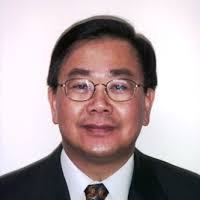
Speaker: Prof. Victor C.M. Leung, Laboratory for Wireless Networks and Mobile Systems Communications Group, Dept. of Electrical and Computer Engineering The University of British Columbia, Vancouver, BC, Canada V6T 1Z4
Title : Robust Access for Wireless Body Area Sensor Networks
Abstract: Recent advances in very-low-power wireless communications have stimulated great interest in the development and application of wireless technology in biomedical applications, including wireless body area sensor networks (WBASNs). A WBASN consists of multiple sensor nodes capable of sampling, processing, and communicating one or more vital signs (e.g., heart rate, brain activity, blood pressure, oxygen saturation) and/or environmental parameters (location, temperature, humidity, light) over extended periods via wireless transmissions over short distances. Low cost implementation and ubiquitous deployment calls for the use of license-exempt ISM bands, in which co-existence of other license-exempt devices, particular WiFi radios, negatively impacts on the robustness of WBASNs. We shall present some proposals to increase the robustness of wireless access in WBASNs by identifying and taking advantages of spectrum holes that are unused by co-existing devices. Simulation and experimental results are presented to show the effective of our proposals in increasing the robustness of channel access in WBASNs.
Invited talk of SPIN 2014

Speaker:Prof. Chin-Hui Lee, PhD Professor, Center for Signal and Image Processing. School of Electrical and Computer Engineering. Georgia Institute of Technology. Atlanta, GA. 30332-0250, USA
Title : Discriminative Training from Big Data with Decision-Feedback Learning
Abstract: Recently discriminative training (DT) has attracted new attentions in speech, language and multimedia processing because of its ability to achieve better performance and enhanced robustness in pattern recognition than conventional model training algorithms. When probabilistic densities are used to characterize class representations, optimization criteria, such as minimum mean squared error (MMSE), maximum likelihood (ML), maximum a posteriori (MAP), or maximum entropy (ME), are often adopted to estimate the parameters of the competing distributions. However the objective in pattern recognition or verification is usually different from density approximation. On the other hand decision-feedback learning (DFL) adjusts these parameters according to the decision made with the current set of estimated discriminants such that it often implies learning decision boundaries. In essence DLF attempts to jointly estimate all the parameters of the competing discriminants all together to meet the performance requirements of a specific problem setting. This provides a new perspective in the recent push of Big Data initiatives especially in cases when the underlying distributions of the data are not completely known. The key to DFL-based DT is that a decision function that determines the performance for a given training set is smoothly embedded in the objective functions so that their parameters can be learned by adjusting their current values to optimize the desired evaluation metrics in a direction guided by the feedback obtained from the current set of decision parameters. Some popular performance criteria include minimum classification error (MCE), minimum verification error (MVE), maximal figure-of-merit (MFoM), maximum average precision (MAP), and minimum area under the receiver operating characteristic curve (MAUC). In theory the DFL-based algorithms asymptotically achieve the best performance almost surely for a given training set with their corresponding features, classifiers and verifiers without using the knowledge of the underlying competing distributions. In practice DFL offers a date-centric learning perspective and reduces the error rates by as much as 40% in many pattern recognition and verification problems, such as automatic speech recognition, speaker recognition, utterance verification, spoken language recognition, text categorization, and automatic image annotation, without the need to change the system architectures.

Speaker: Prof. Dr.-Ing. Ulrich Heute Professor at the Faculty of Engineering (TF), Christian-Albrechts-University Kiel since 10 / 93 D-24143 Kiel, Germany
Title: DSP for Brain Signals
Abstract: All human activities originate from and lead to electrical events in the central nervous system. The corresponding currents may be recorded by the well established electro-encephalography (EEG) or the relatively new magneto-encephalography (MEG). Both yield complementary information. Especially, MEG signals with existing superconducting sensors (SQUID MEG) or with new room temperature sensors developed in a large project at Kiel deliver tiny signals. Their measurement in an unshielded surrounding needs sophisticated analog pick-up electronics, filtering disturbances as much as possible. However, a certain component may be disturbing in one application, but carry information in another one. So, dedicated removal of well-defined signal parts after digitization of a not too much pre-processed signal is preferable.By means of Digital Signal Processing (DSP), activities which are irrelevant for a given investigation,but especially different types of noise as well as strong endogeneous and exogenous artifacts can be removed. Within the above large project, algorithms for this task have been developed and applied: Noise originating from various sources (thermal noise, shot noise, Barkhausen noise) can be treated via linear (digital) filters, adaptive Wiener filtering, or Empirical Mode Decomposition (EMD). By EMD, also slowly varying offsets (trends) can be removed, as well as muscle artifacts. Muscle and eyemovement artifacts may be tackled via Independent-Component Analysis (ICA), combined with, again, simple filtering or, better, Kalman filtering. Also, artifact components after ICA may have to be cleaned from other activities by Wiener filtering before removal. Among external artifacts, the classical power-supply harmonics have to be dealt with. Simple notch or comb filters have disadvantages; a hybrid filter, designed signal-adaptively in frequency domain and applied in time domain, is the best, though expensive solution also for the strong harmonic disturbances from a deep-brain stimulator. For certain artifacts, reference signals may be available, e, g. an ECG for heartbeat artifacts in EEG and MEG; then, a compensation after adaptive equalization is possible. The same holds for eye-blinking artifacts with an additional oculogram measurement.

Speaker:Prof. Dong Hwa Kim Professor at Dept. of Instrumentation and Control Engineering, Hanbat National University, 16-1 Duckmyong dong Yuseong gu Daejeon, South Korea 305-719
Title: Research Experience on Artificial Intelligence and Emotion Control, and Realistic Information Exchange System
Abstract: First of all, this lecture presents research experience such as immune system, genetic algorithm, particle swarm optimization, bacterial foraging, and its hybrid system and application to real system. This lecture will also show research experience and results of emotion for emotion robot by AI. From research experience, immune system, PSO (Particle Swarm Optimization), BF (Bacteria Foraging), and hybrid system can have strong optimization function for engineering fields. In detailed description, this lecture describes research background about immune network based intelligent algorithm, PSO based intelligent algorithm, bacteria foraging based intelligent algorithm, and the characteristic of novel algorithm fusioned by their algorithm. This one also illustrates motivation and background that these algorithms should be applied to in the industry's automatic system. Second, this lecture illustrates immune algorithm and applied to various plant to investigate the characteristics and possibility of application. As the detailed description, immune algorithm will described by studied material to investigate possibility of application to plant. It suggests condition for disturbance rejection control in AVR of thermal power plant and introduce first into tuning method of its controller. In the conventional genetic algorithm, it takes a long time to compute and could not include a variety of information of plant because of using sequential computing methods. That is some problem with making a artificial intelligence for optimization. In this lecture, by means of introducing clonal selection of immune algorithm into computing procedure, it will be showed advanced results. That is, it can be calculated simultaneously necessary information, transfer function, time constant, and etc., for plant operation condition. Therefore, computing time is about 30% shorter than that of the conventional genetic algorithm and 10.6% smaller in overshoot when it is applied to controller. This lecture will introduce parameter estimation method by immune algorithm for obtaining model of induction motor. It will suggest immune algorithm based induction motor parameter estimation to obtain optimal value depending on load variation from these parameters. Also, this lecture will introduce about intelligent system using GA-PSO. It will introduce Euclidean data distance to obtain fast global optimization not local optimization by means of using wide data and suggests novel hybrid system GA-PSO based intelligent tuning method that genetic algorithm and PSO (Particle Swarm Optimization) is fusioned

Speaker: Prof. Irene Y.H. Gu Professor, Signal Processing Group, Dept. of Signals and Systems, Chalmers University of Technology, Gothenburg, 41296, Sweden
Title: Domain-Shift Object Tracking: manifold learning and tracking of large-size video objects with out
Abstract:Many dynamic objects in videos contain out-of-plane pose changes accompanied by other deformation and long-term partial occlusions, and the size of objects could be large in images. In such scenarios, visual tracking using video from a single camera is challenging. It is desirable that trackers be performed on some smooth manifolds in such scenarios. Stochastic modeling on manifolds is also important for tracking robustness. In this talk, domain-shift tracking and learning on smooth manifolds are addressed. First, we review some basic concepts of manifolds and some commonly-used manifold tracking methods. We then present a nonlinear dynamic model on a smooth (e.g. Grassmann, Riemannian) manifold, from which Bayesian formulae are built on the manifold, rather than in a single vector space as in the conventional cases. Based on the model, particle filters are employed on the manifold. We also consider domain-shift online learning with occlusion handling. While it is essential for learning dynamic objects including deformable out-of-plane motion for reducing tracking drift, one also needs to prevent the learning when changes are caused by other occluding objects or clutter. We show some examples of such online learning approaches. Finally, some demonstrations and evaluations from such a domain-shift tracker are shown, along with comparisons of results to several state-of-the-art methods.

Speaker: Prof. Patrick Gaydecki Professor, Sensing, Imaging and Signal Processing Group, School of Electrical and Electronic Engineering, University of Manchester Manchester M60 1QD, United Kingdom
Title: Intuitive Real-Times Platform for Audio Signal Processing and Musical Instrument Response Emulation
Abstract: In recent years, the DSP group at the University of Manchester has developed a range of DSP platforms for real-time filtering and processing of acoustic signals. These include Signal Wizard 2.5, Signal Wizard 3 and Vsound. These incorporate processors operating at 100 million multiplication-accumulations per second (MMACs) for SW 2.5 and 600 MMACS for SW 3 and Vsound. SW 3 features six input and eight output analogue channels, digital input/output in the form of S/PDIF and a USB interface. For all devices, The software allows the user, with no knowledge of filter theory or programming, to design and run standard or completely arbitrary FIR, IIR and adaptive filters. Processing tasks are specified using the graphical icon based interface. In addition, the system has the capability to emulate in real-time linear system behavior such as sensors, instrument bodies, string vibrations, resonant spaces and electrical networks. Tests have confirmed a high degree of fidelity between the behavior of the physical system and its digitally emulated counterpart. In addition to the supplied software, the user may also program the system using a variety of commercial packages via the JTAG interface.

Speaker: Dr. Karlheinz Brandenburg Professor, Institut fuer Medientechnik, TU, Ilmenau PF 100565, 98684 Ilmenau, Helmholtzplatz 2 Fraunhofer- Institut Digitale Medientechnologie Ehrenbergstr. 31, 98693, Ilmenau, Germany
Title: Audio and Acoustic Signal Processing: The quest for High Fidelity Continues
Abstract:The dream of high fidelity continues since more than 100 years. In the last decades, signal processing has contributed many new solutions and a vast amount of additional knowledge to this field. These include simple solutions like matrix multichannel systems, Audio coding which changed the world of music distribution and listening habits active noise control, active modification of room acoustics, Search and recommendation technologies to find your favourite music and many more. So are there any problems left to be solved? Among others, I see two main research areas: Music Information Retrieval (MIR), helping us to find and organise music, or teaching playing musical instruments and Immersive technologies for movie theatres and eventually our homes, creating the illusion of being at some other place For such systems we use our knowledge about hearing, especially how ear and brain work together to form the sensation of sound. However, our knowledge about hearing, about psychoacoustics is still far from complete. In fact, just in the last few years we have learned a lot about what we dont know. The talk will touch on a number of the subjects above, explain some current work and its applications and finally talk about open research questions regarding psychoacoustics and the evaluation of audio quality.

Speaker: Patrizio Campisi Ph.D. Professor, Section of Applied Electronics, Department of Engineering, Universit degli Studi Roma TRE, Via Vito Volterra 62, 00146 Roma, Italy
Title: Biometrics and Neuroscience: a marriage possible?
Abstract: In the recent years, biometric recognition, that is the automated recognition of individuals based on their behavioral and biological characteristics, has emerged as a convenient and possibly secure method for user authentication. In this talk we infer about the feasibility of using brain signals as a distinctive characteristic for automatic user recognition. Despite the broad interest in clinical applications, the use of brain signals sensed by means of electroencephalogram (EEG) has been only recently investigated by the scientific community as a biometric characteristic. Nevertheless, brain signals present some peculiarities, not shared by the most commonly used biometrics, like face, iris, and fingerprints, concerning privacy compliance, robustness against spoofing, possibility to perform continuous identification, intrinsic liveness detection, and universality, which make the use of brain signals appealing. However, many questions remain open and need a deeper investigation. Therefore in this talk, taking a holistic approach, we speculate about issues such as the level of EEG stability in time for the same user, the user discriminability that EEG signals can guarantee, and the relationship of these characteristics with the different elements of the employed acquisition protocol such as the stimulus, the electrodes displacement and number, etc. A detailed overview and a comparative analysis of the state of the art approaches will be given. Finally, the most challenging research issues on the design of EEG based biometric systems is outlined.

Speaker: Prof. Philip James Wilkinson, Australia President, International Union of Radio Science (URSI) Member URSI/COSPAR Working Group on International Reference Ionosphere
Title: URSI - what is its role in the 21st century?
Abstract: The heart of URSI (The International Union of Radio Science) is radio science, an enabling science that permeates society and is central to all technology. The founding body of URSI met in Belgium, in 1914, and the first URSI General Assembly took place in Belgium, in 1922. URSI joined the IRC (International Research Council (1919-1931) in 1922 and in 1931 the IRC became ICSU (now The International Council for Science) making URSI a founding scientific Union of ICSU. How relevant is such an historic body as URSI one hundred years after it was formed? This address will not answer that question directly, nor the equivalent question in the title for this talk. Instead, some of the ingredients for future success will be put forward, which includes a selection of the new science URSI scientists engage in as well as the changes URSI will promote in coming years.

Speaker: Prof. Kazuya Kobayashi Department of Electrical, Electronic, and Communication Engineering, Chuo University, Tokyo, Japan President of the Japan National Committee of URSI
Title: Rigorous Radar Cross Section Analysis of a Finite Parallel-Plate Waveguide with Material Loading
Abstract: The analysis of electromagnetic scattering by open-ended metallic waveguide cavities is an important subject in the prediction and reduction of the radar cross section (RCS) of a target. This problem serves as a simple model of duct structures such as jet engine intakes of aircrafts and cracks occurring on surfaces of general complicated bodies. Some of the diffraction problems involving two- and three-dimensional cavities have been analyzed thus far based on high-frequency techniques and numerical methods. It appears, however, that the solutions due to these approaches are not uniformly valid for arbitrary dimensions of the cavity. Therefore it is desirable to overcome the drawbacks of the previous works to obtain solutions which are uniformly valid in arbitrary cavity dimensions. The Wiener-Hopf technique is known as a powerful, rigorous approach for analyzing scattering and diffraction problems involving canonical geometries. In this contribution, we shall consider a finite parallel-plate waveguide with four-layer material loading as a geometry that can form cavities, and analyze the plane wave diffraction rigorously using the Wiener-Hopf technique. Both E and H polarizations are considered. Introducing the Fourier transform of the scattered field and applying boundary conditions in the transform domain, the problem is formulated in terms of the simultaneous Wiener-Hopf equations. The Wiener-Hopf equations are solved via the factorization and decomposition procedure leading to the exact solution. However, this solution is formal since infinite series with unknown coefficients and infinite branch-cut integrals with unknown integrands are involved. For the infinite series with unknown coefficients, we shall derive approximate expressions by taking into account the edge condition. For the branch-cut integrals with unknown integrands, we assume that the waveguide length is large compared with the wavelength and apply a rigorous asymptotics. This procedure yields high-frequency asymptotic expressions of the branch-cut integrals. Based on these results, an approximate solution of the Wiener-Hopf equations, efficient for numerical computation, is explicitly derived, which involves a numerical solution of appropriate matrix equations. The scattered field in the real space is evaluated by taking the inverse Fourier transform and applying the saddle point method. Representative numerical examples of the RCS are shown for various physical parameters, and the far field scattering characteristics of the waveguide are discussed in detail. The results presented here are valid over a broad frequency range and can be used as a reference solution for validating other analysis methods such as high-frequency techniques and numerical methods.

Speaker: Prof. Dr. Sneh Anand Centre for Biomedical Engineering Indian Institute of Technology Delhi
Title: Intelligent Real Time Biological Signal Processor
Abstract: Human brain is a unique Ideal intelligent signal processor in the world. In the human brain, the salience activities operate at supernatural level. The mother board and the CPU are intervened at subcellular and physiological levels. The delusion to think that everything outside is a volume of space not you and outside of you. The fact is that, sense of presence that is you are everywhere. The main reason that you have more awareness of being in a body is simply because of the multi-sensory intelligence of the body commands. We have the illusion that our human bodies are solid, but they are over 99.99% empty space. Input signals operate at emotional, environment and attention levels, besides the multiple physical electromagnetic chemical mechanical and microbiological structural changes. Living system is complex that intelligently coordinates the communication channels at atomic and subatomic level between body brain and mind, Natural environment plays very vital role in programming the millions upon millions of processes occurring in the body at quantum physical level. The human system transforms itself. Ancient physicians were physicists that are adapted in modern medicine and developed medical technologies. Biological sensors operate at algorithms that are different in all species however the human brain networks are most complex self-programmed processors.









